Latest Posts
Passover 2024 begins at sundown Monday, April 22, and ends at sundown on Tuesday, April 30. In this blog post, CHM curator of religion and community history Rebekah Coffman writes about the Chicago Loop Synagogue and a Passover Seder shared by its rabbi, Irving Rosenbaum, in 1966.
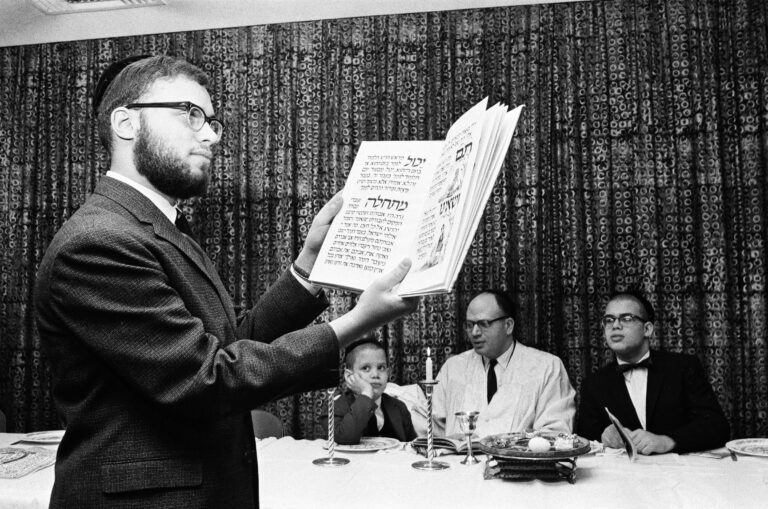
A Seder table with Rabbi Irving Rosenbaum (seated, center) and his sons at Chicago Loop Synagogue, March 31, 1966. ST-11005561-0005, Chicago Sun-Times collection, CHM
This set of images shows a staged Passover meal taking place at the Chicago Loop Synagogue in 1966. Featured center is Roy Rosenbaum (age 19) reading to his father, Rabbi Irving Rosenbaum, and his two brothers, Alan (age 6) and Don (age 15). Roy is holding a Haggadah, a book that details the order of the Passover meal, known as the seder (seder, in fact, means “order”). It outlines stories from the Book of Exodus and includes a series of blessings, songs, actions, and ceremonial foods and drinks as a guide for families and communities through the symbolic meal.
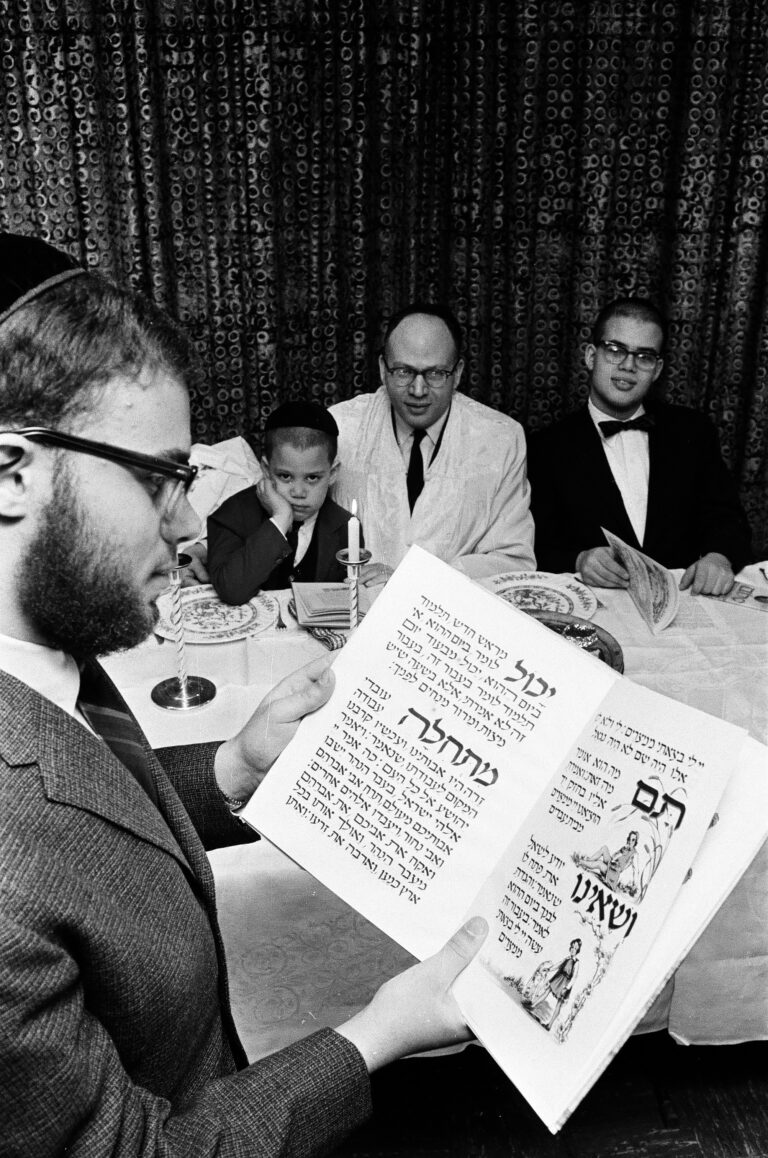
Roy Rosenbaum reads from a Haggadah during a Seder at Chicago Loop Synagogue, March 31, 1966. ST-11005561-0001, Chicago Sun-Times collection, CHM
Roy is reading pages from a section in the seder that discusses four sons or four children: the wise, the wicked, the simple-natured, and the one who doesn’t know how to ask. These children represent different ways of approaching and learning about the story of Passover. The Haggadah next shares the Exodus story as a movement from slavery toward freedom. While seders are often something done at home with family, they may also be done in synagogues or in larger community, all with an emphasis of passing the story through the generations and recalling humankind’s search for freedom.
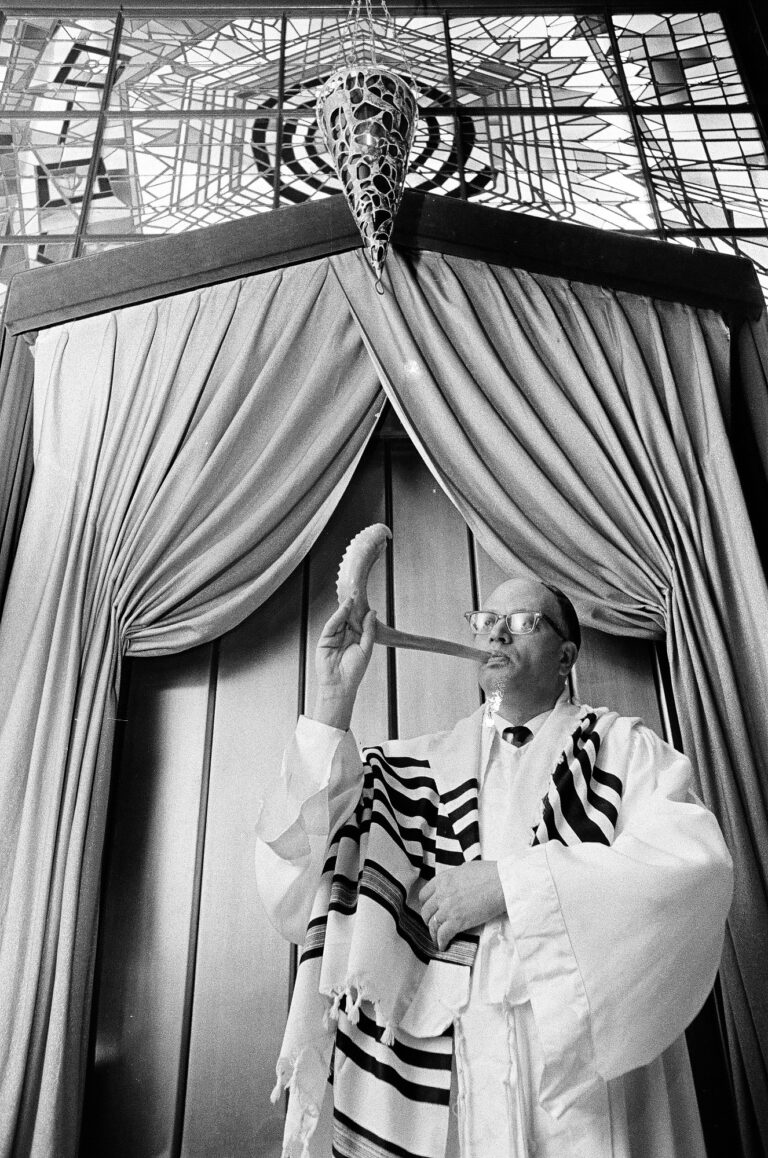
Rabbi Irving J. Rosenbaum blows a shofar during Rosh Hashanah services at the Chicago Loop Synagogue, September 20, 1968. ST-11005551-0007, Chicago Sun-Times collection, CHM
Rabbi Irving J. Rosenbaum (c. 1922–2005) served as rabbi of Chicago Loop Synagogue for 14 years. Born in Omaha, Nebraska, Rabbi Rosenbaum moved to the Chicago area for school at age 16. He attended the University of Chicago in Hyde Park and Hebrew Theological College in Skokie, graduating in the 1940s. In 1946, he served as the National Director of the Department of Interreligious Cooperation for the Anti-Defamation League of B’nai B’rith. Rabbi Rosenbaum was especially dedicated to education, including in interfaith settings. For example, he produced a film and accompanying booklet for non-Jews called Your Neighbor Celebrates to explain Jewish religious practice and holidays. This fervent interest in religious education was passed down to the next generation, as all three of his sons would go on to also become rabbis.
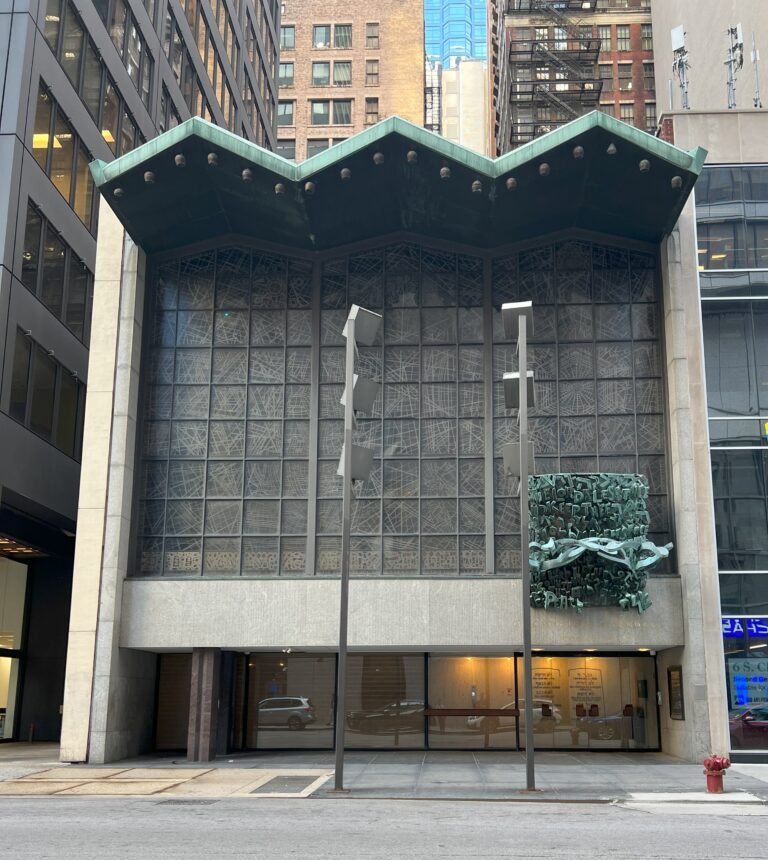
Chicago Loop Synagogue as seen from Clark Street, 2022. Photograph by Rebekah Coffman
Chicago Loop Synagogue was founded in 1929 to provide a space for Jewish professionals working downtown. The community began by renting different spaces around the Loop for daily and Friday evening (Kiddush) prayers. In the 1950s, they were inspired to construct a purpose-built synagogue after seeing Temple Har Zion in River Forest, Illinois, completed in 1951. They commissioned Har Zion’s architects—Loebl, Schlossman, and Bennet—to design their current building on South Clark Street between Madison and Monroe Streets, completed in 1958.
Today known as Loebl, Schlossman, and Hackl, the synagogue designers’ firm was founded in 1925, with the practice’s name shifting in passing decades as new partners and collaborators joined and left over time. Their founding namesakes, Jerrold Loebl and Norman Schlossman, had grown up in Hyde Park and both studied architecture at Armour Institute of Technology (today Illinois Institute of Technology). Richard M. Bennet, who was originally from Pennsylvania and had studied at Harvard University, joined Loebl and Schlossman in 1947, shifting the practice’s name to Loebl, Schlossman and Bennet for the next two decades until joined by a fourth architect, Edward Dart, in 1965. They designed several impressive synagogues, including Lakeview’s Temple Sholom (1928), but their legacy extends much further through various planned projects and urban renewal schemes, especially in the Bronzeville neighborhood, as well as public housing, suburban developments such as Park Forest, and downtown Chicago’s Richard J. Daley Center.
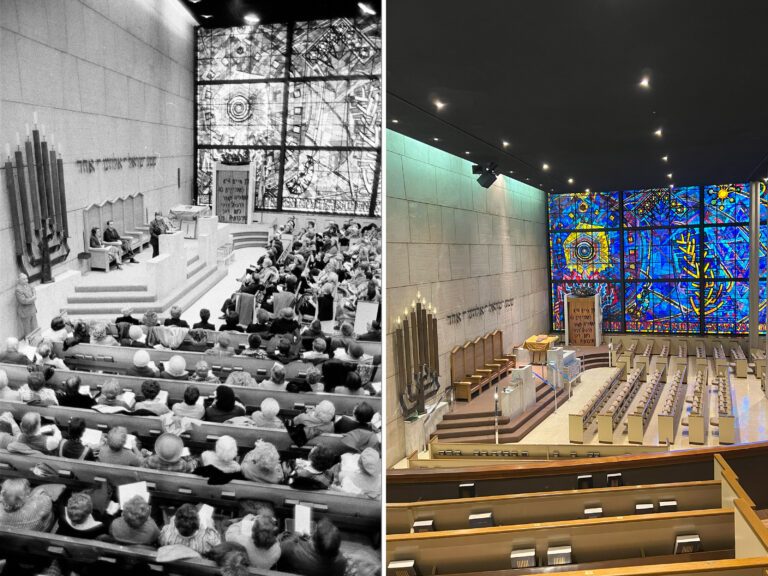
Left: Women speak to the congregation regarding Soviet Jews at the Chicago Loop Synagogue, December 10, 1979. ST-60002959-0001, Chicago Sun-Times collection, CHM. Right: Loop Synagogue sanctuary interior, 2022. Photograph by Rebekah Coffman
Loop Synagogue was designed not only to be architecturally and artistically beautiful but also includes layers of symbolic meaning as well as practical design to facilitate Orthodox Jewish needs. Two primary examples of this are in the main worship space. First, in place of an elevator, a long ramp leads between the first and second story to facilitate easy access for congregants unable to use the stairs. Since a traditional elevator uses electricity, its use would be prohibited on Shabbat for Orthodox Jews, so the ramp permits moving between levels while aligning with this prohibition.
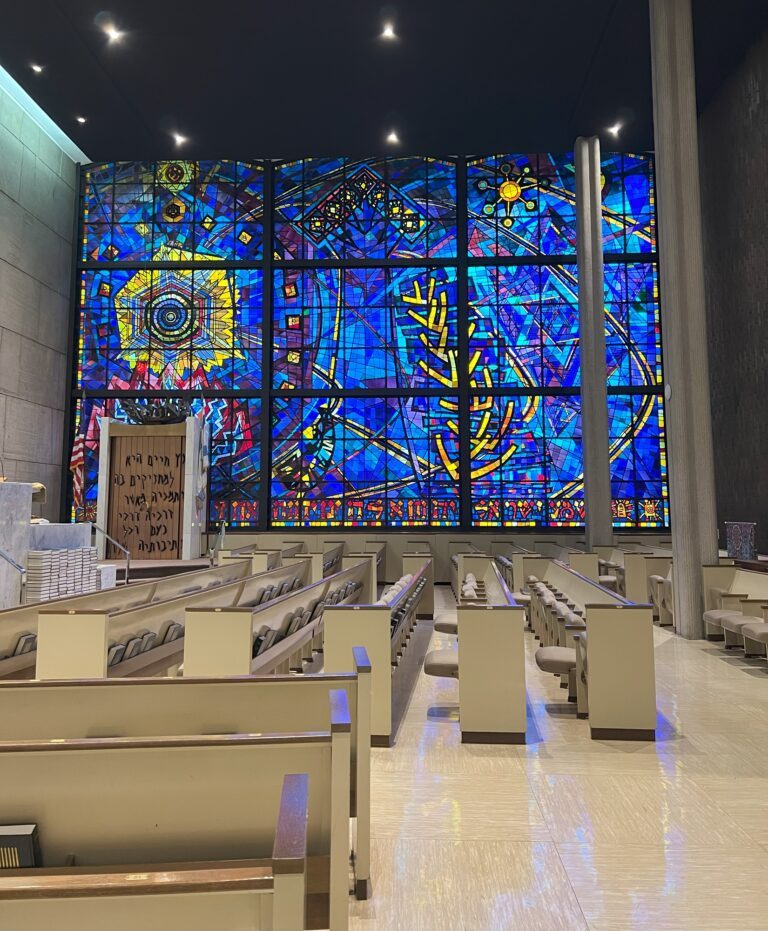
Stained glass window by Abraham Rattner in Loop Synagogue’s sanctuary, 2022. Photograph by Rebekah Coffman
Similarly, as lights also usually require electricity, the sanctuary’s east side has an extraordinary stained glass window that runs nearly floor to ceiling. Designed by Abraham Rattner and considered one of the finest windows of its kind, its impressive size also serves a practical purpose by letting in plentiful, colorfully filtered light. The window, called Let There Be Light, is based on the scripture Genesis 1:3 and includes symbolic and literal references to light, including flames as a symbol of Divine presence and a seven-branched Menorah symbolizing inner light.
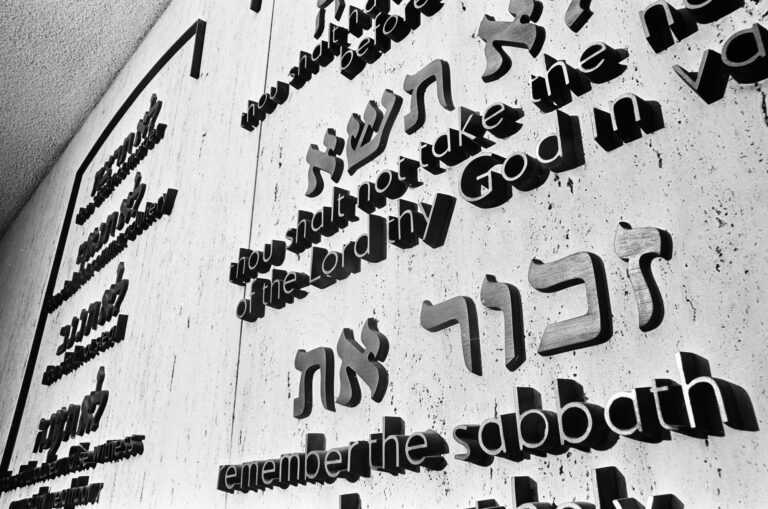
View of the Ten Commandments in both Hebrew and English at the Chicago Loop Synagogue, May 21, 1969. ST-19042097-0003, Chicago Sun-Times collection, CHM
Another beautifully symbolic element sits at the threshold of the building, visible from the street and just inside the synagogue’s entrance doors. A sculpture of the Ten Commandments, both in English and Hebrew, acts as bridge from the outside world to the inside’s sacred space.

Hands of Peace sculpture by Nehemia Azaz above the entrance to Chicago Loop Synagogue, 2022. Photograph by Rebekah Coffman
Religious practice downtown has shifted dramatically in recent years, compounded with the onset of the COVID-19 pandemic, leading to a significant decline in membership for the synagogue. The synagogue’s community, led by President Lynn Zoldan, continues to think of creative ways to serve their Jewish congregation while welcoming new uses to help preserve the space for the future. Outside the synagogue’s entrance on Clark Street is Nehemia Henri Azaz’s impressive Hands of Peace sculpture, which places the outstretched hands of the priestly benediction said over congregants against a backdrop of its very words in both English and Hebrew, serving as a blessing for those outside passing by.
Further Reading
- Read the entry on Jews in the Encyclopedia of Chicago
- Read the entry on Judaism in the Encyclopedia of Chicago
- Read the entry on the Loop in the Encyclopedia of Chicago
- Read the blog post “Hag Pesach Sameach: Passover and Chicago’s Jewish Communities“
- View the HABS documentation for Chicago Loop Synagogue
Grant funding will support the planning of an upcoming exhibition celebrating Latine history and cultures in Chicago
CHICAGO (April 18, 2024) – The Chicago History Museum (CHM) is thrilled to announce that it has been awarded a grant of $74,000 from the National Endowment for the Humanities (NEH) to support its project “Aquí en Chicago.” This grant will facilitate the planning of the dynamic temporary exhibition exploring the rich history and vibrant cultures of the Latine people of Chicago.
With “Aquí en Chicago,” CHM seeks to deepen its commitment to inclusivity and representation and celebrate the persistent cultural presence and significant contributions of Latine Chicagoans to the city’s history. Elena Gonzales, CHM Curator of Civic Engagement & Social Justice, expressed gratitude for the support from NEH, stating, “Thank you, NEH, for supporting the preparation for ‘Aquí en Chicago.’ Again and again, partners and community members have shared how vital they feel it is for the Museum to build its inclusiveness and representation of the Latine third of the city, and NEH is helping us do this crucial work.”
The project will encompass a range of initiatives aimed at celebrating and preserving the cultural heritage of Latine communities in Chicago. This includes the development of a 2,900-square-foot temporary exhibition, scheduled to open in fall 2025, as well as paid research internships, an oral history project and a series of workshops focused on collecting and preserving cultural heritage. Throughout the planning process, the Chicago History Museum is actively collaborating with community organizations to ensure the intersectionality of Latine experiences in Chicago is accurately represented and celebrated.
Veronica Casados, CHM Public Communications Manager, is available for further inquiries or interview requests regarding the project. For more information about “Aquí en Chicago” and the Chicago History Museum, please visit: https://www.chicagohistory.org/aqui-en-chicago/
###
ABOUT THE CHICAGO HISTORY MUSEUM
The Chicago History Museum is situated on ancestral homelands of the Potawatomi people, who cared for the land until forced out by non-Native settlers. Established in 1856, the Museum is located at 1601 N. Clark Street in Lincoln Park, its third location. A major museum and research center for Chicago and U.S. history, the Chicago History Museum strives to be a destination for learning, inspiration, and civic engagement. Through dynamic exhibitions, tours, publications, special events and programming, the Museum connects people to Chicago’s history and to each other. The Museum collects and preserves millions of artifacts, documents, and images to assist in sharing Chicago stories. The Museum gratefully acknowledges the support of the Chicago Park District on behalf of the people of Chicago.
ABOUT THE NATIONAL ENDOWMENT FOR THE HUMANITIES
Created in 1965 as an independent federal agency, the National Endowment for the Humanities supports research and learning in history, literature, philosophy, and other areas of the humanities by funding selected, peer-reviewed proposals from around the nation. Additional information about the National Endowment for the Humanities and its grant programs is available at: www.neh.gov.
In this blog post, CHM director of research and access Ellen Keith highlights some of the house history resources in the Abakanowicz Research Center.
Are you a Chicago resident who’s curious about the history of your home? If so, come visit the Abakanowicz Research Center! Our librarians are happy to assist you in navigating the resources in our Building and House History Guide.
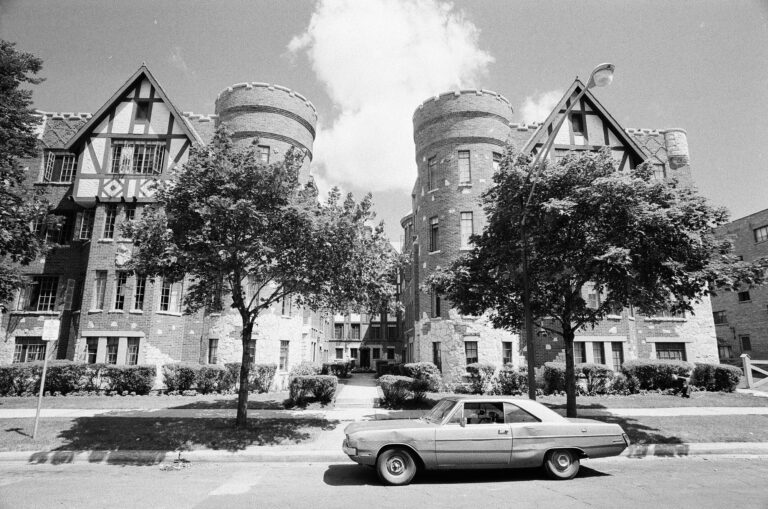
A castle-like apartment complex at 2556 West Fitch Avenue in the Rogers Park community area, Chicago, July 10, 1975. ST-90003352-0012, Chicago Sun-Times collection, CHM
Where to begin?
Let’s start with building permits. Often a house history researcher comes in wanting to confirm the date their home was built. We have building permits on microfilm from 1872 to 1954 (think the year after the 1871 Great Chicago Fire to the year before Richard J. Daley was elected mayor). Depending on the year the permit was filed, you can get varying amounts of information. Architects were included on permits after 1912. The University Library of the University of Illinois Chicago has digitized the microfilm.
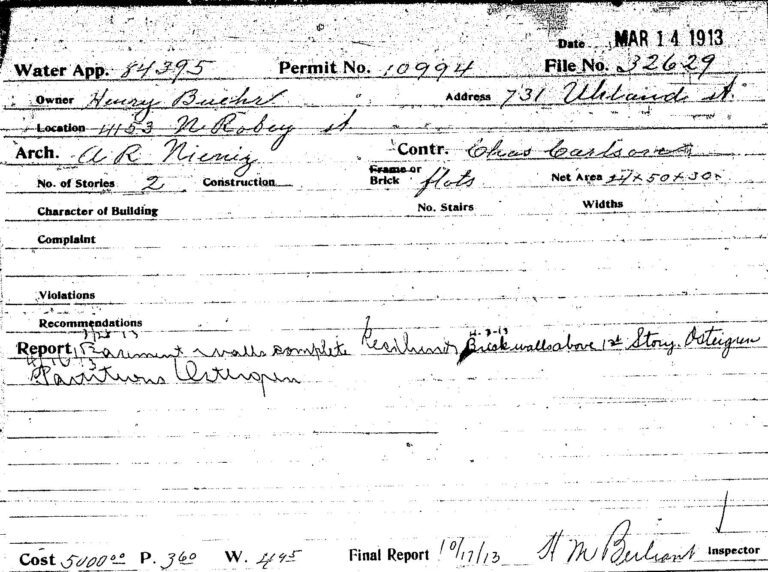
A building permit ledger entry for 4153 North Robey Street, which is now Damen Avenue, March 14, 1913.
Next, do we have a photograph of your home? We have a large collection of photographs arranged by subject, and the photographs of streets are among the most popular. If you’re interested in a specific area, the Sigmund J. Osty visual materials, approximately 1960–76, are organized by neighborhood.
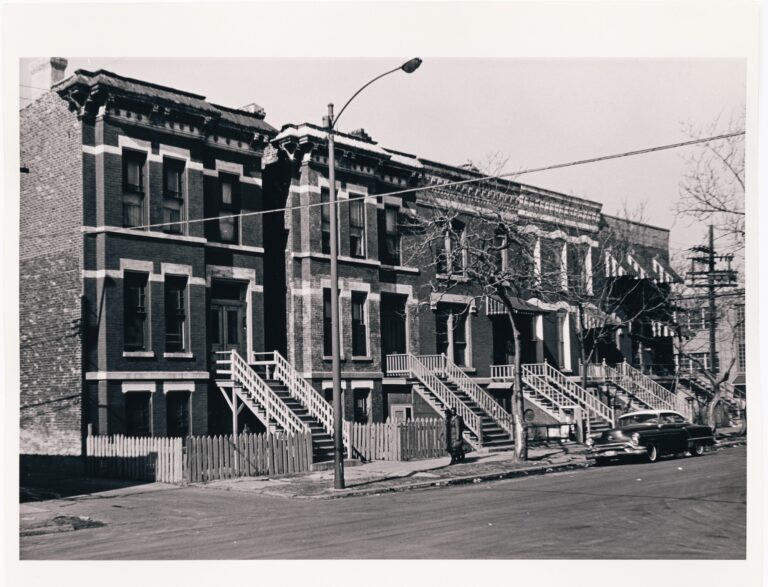
The 300 block of South Wolcott Avenue, Chicago, February 29, 1964. CHM, ICHi-074046; Sigmund J. Osty, photographer. These buildings do not appear to exist any longer, possible casualties of the Illinois Medical District.
If you’re interested in how your neighborhood has changed over time, a.k.a. the built environment, do we have a resource for you! Fire insurance maps are snapshots of a place in time. They were published to assess risk so the outlines of buildings are color coded with yellow for frame, pink for brick, and blue for stone. Buildings are also labeled with “S” for Store, “D” for Dwelling, and “F” for Flat. Our collection spans from the 19th to the later 20th century (1975 is the most recent). Each numbered volume covers a portion of the city and when there are multiple years for a volume, you can see your neighborhood change over time from a few buildings to a block early on and then in later years, blocks are filled in, and often what were single family homes (dwellings) are now flats (apartment buildings).
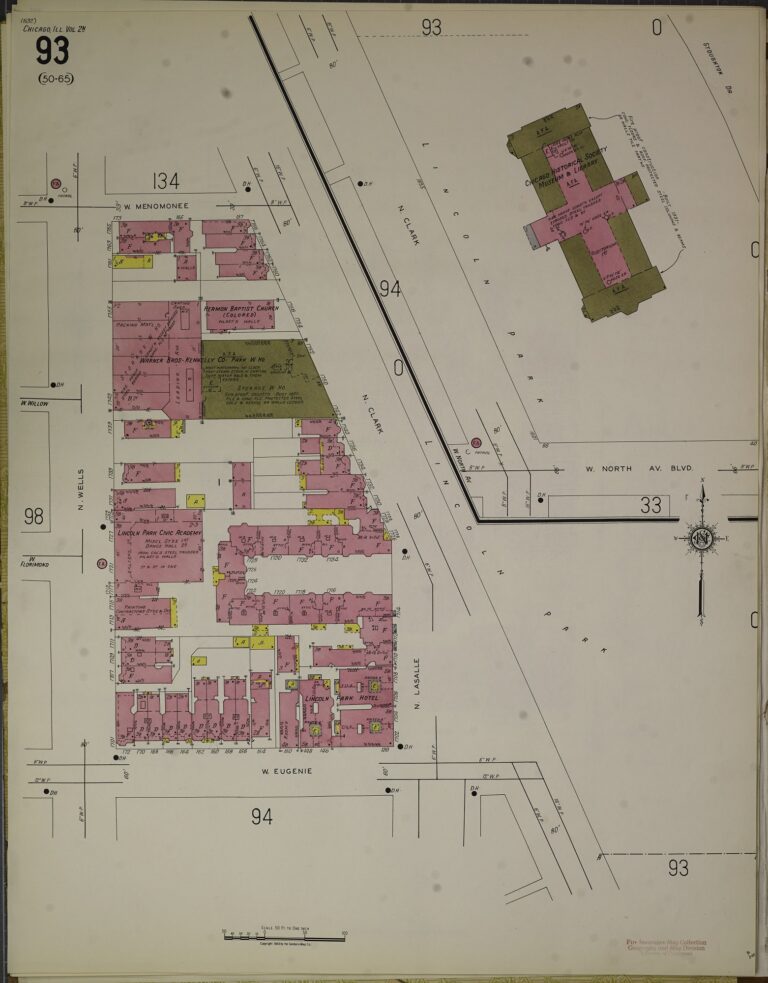
Sanborn Fire Insurance Map from Chicago, Cook County, Illinois. Sanborn Map Company, Vol. 2, North, 1935. Map. The Chicago History Museum (then the Chicago Historical Society) original 1932 building is in the top right corner.
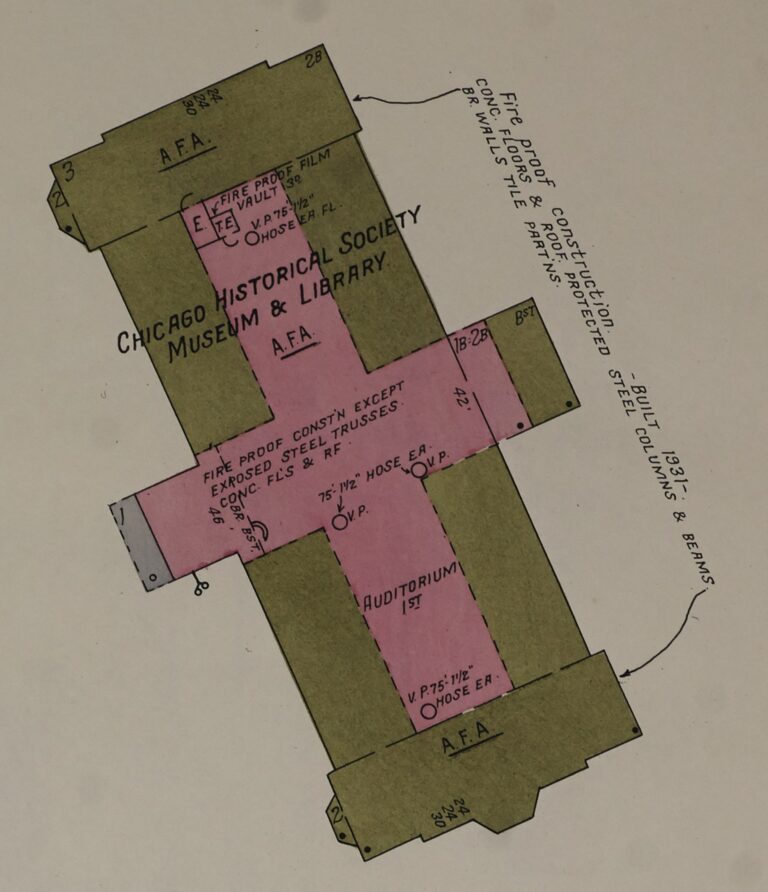
A close-up view of the “Chicago Historical Society Museum & Library,” which has “fire proof construction.”
Physical fire insurance maps are quite impressive. They’re very large and were expensive to reprint so when a volume was updated, corrections were pasted over the originals, which makes looking at them quite a tactile experience as pages get thicker and thicker with their corrections. If you’re not able to visit, however, there’s an excellent website, Guide to Chicago Sanborns volumes, that links to those freely available through the Library of Congress and the University of Illinois. (Note: that link goes to the archived site, as the site’s owner, cartographer Dennis McClendon, passed away in 2024.)
Please note that streets were renumbered in 1909 and street names changed continuously, so if you’re looking at a volume published prior to 1909, you’ll want to use our address conversion guide to determine the old address of your home.
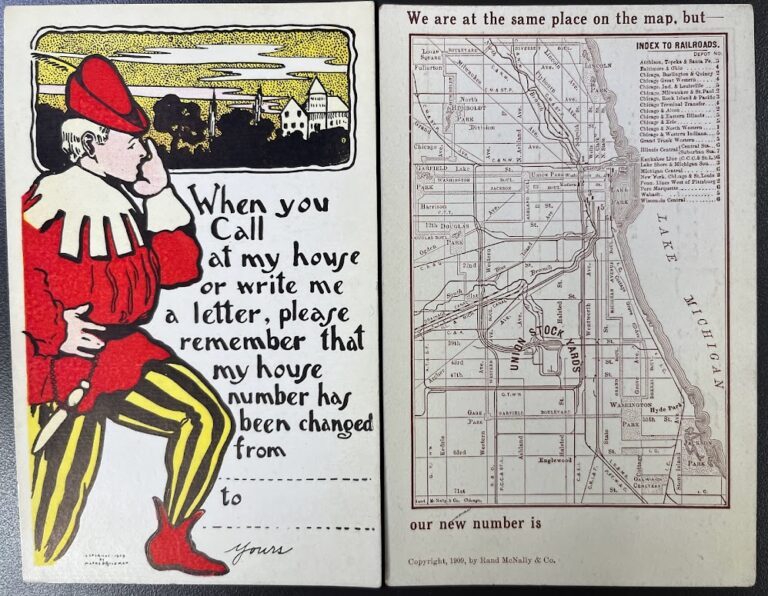
Two examples of commercially produced postcards for Chicago residents to explain their new addresses to friends, family, and business associates following the standardization of street numbering, c. 1909. Gift of Donald Friedman (2003.0246.1-31). Photograph by Ellen Keith
Do you think you have a home built from a kit? You may want to look at our catalogs of “prefabricated homes.” We also have a book of floor plans of selected apartment buildings.
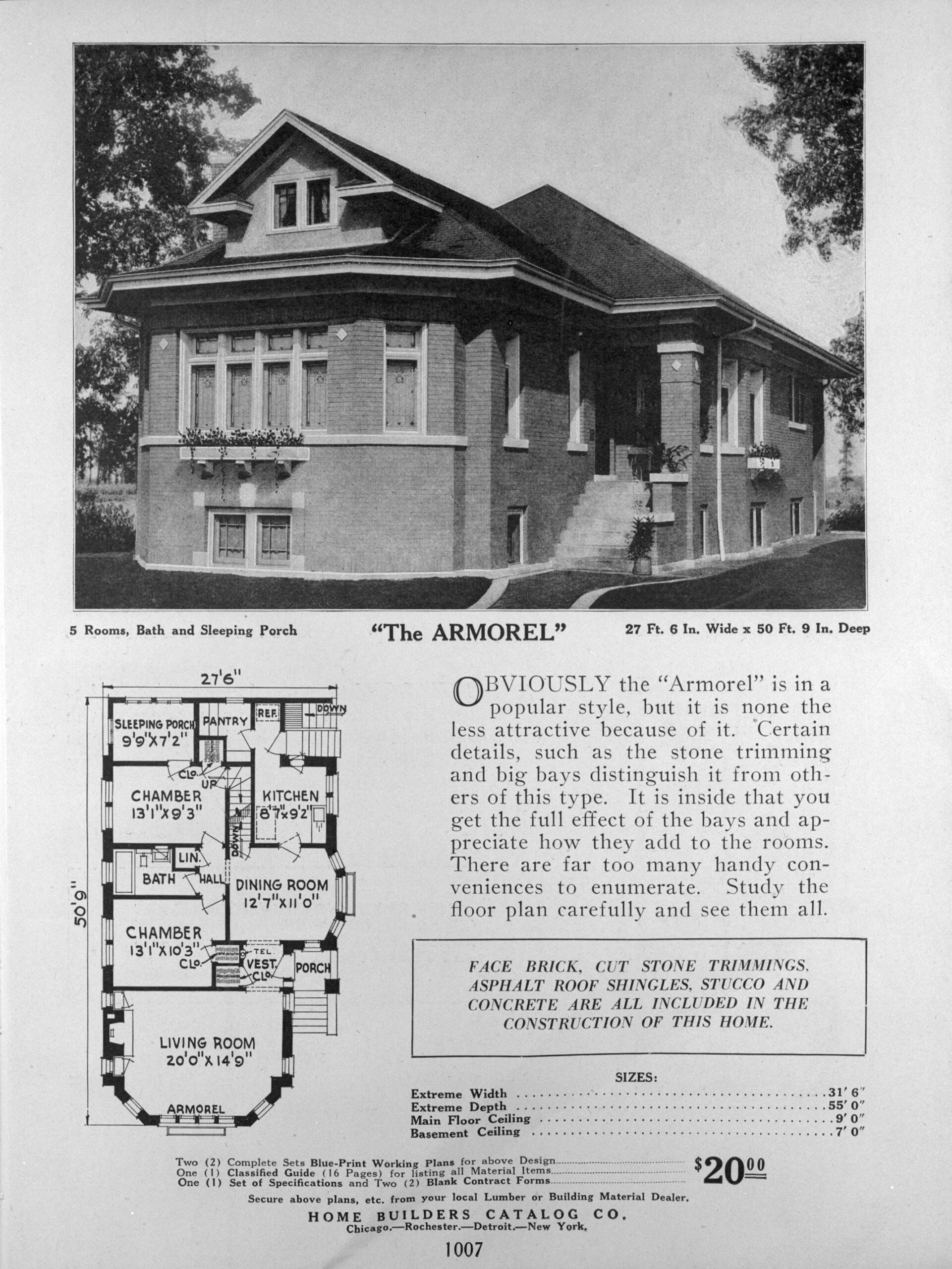
A picture, floor plan, and text describing a bungalow called “The Armorel,” Home Builders Catalog, 1926. TH455 .H6 OVERSIZE. CHM, ICHi-015886
There’s more we can do from searching newspaper databases for articles that reference your address to checking crisscross directories and blue books for former residents. We love assisting researchers with house history, so come see us to get started!
Additional Resources
- The Chicago Bungalow Association equips homeowners with energy efficiency programs and educational resources to maintain, preserve, and adapt their Chicago bungalows and vintage homes, thereby strengthening the neighborhoods they anchor.
- The Chicago Workers Cottage Initiative celebrates this housing style, seeking to preserve the unique features of these houses, protect them from demolition, and continue their use and reuse for the next century.
- Logan Square Preservation is a community organization dedicated to educating citizens about architecture, history, and beautification.
In this blog post, CHM registrar Jamie Lewis writes about the Native American Graves Protection and Repatriation Act (NAGPRA) and how the Chicago History Museum is working to improve the stewardship of its Native American holdings.

The gallery in Chicago: Crossroads of Chicago that discusses the region’s Indigenous tribes and European colonization. All photographs by Jamie Lewis.
Over the past year, the Chicago History Museum (CHM) has been making a few changes in how we display and handle Native American cultural items. Along with other museums in the United States, including the Field Museum and American Museum of Natural History, we are ensuring continued Native American Graves Protection and Repatriation Act (NAGPRA) compliance following recent legislative changes and making a concerted effort to enhance practices regarding the care and interpretation of collections and acknowledging Native tribes as experts of their own histories.
What has CHM removed from display and why?
CHM has removed several items from display in the exhibition Chicago: Crossroads of America on the Museum’s second floor as well as from the small alcove in Imagining Chicago: The Dioramas on the first floor. These cultural items are either known or likely to have been taken from Native American burials. We consider these types of items to be “culturally sensitive,” meaning that there is a cultural reason for us not to display them, and there may be special, culturally specific guidelines for caring for them. While some non-Native people may feel that displaying funerary items is acceptable, CHM believes most Native American communities do not want these types of items on public view. And in fact, some believe that museums should not really have them at all. NAGPRA, passed in 1990, is one legislative measure that was created to ensure the protection of Native burials and to facilitate the return of human remains (or ancestors) and funerary objects, as well as other important cultural items.
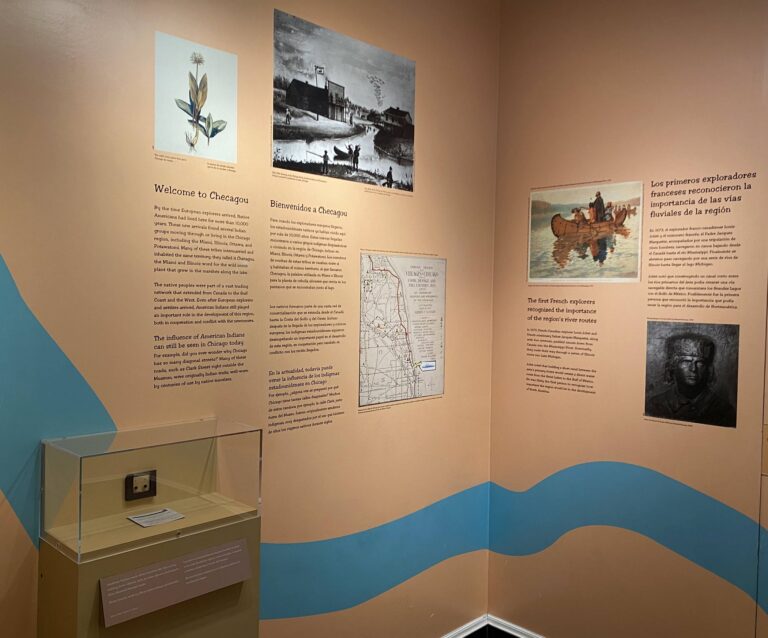
The Native American section of Imagining Chicago: The Dioramas.
What is the purpose of NAGPRA?
The looting of Native American burials and sacred sites has been part of the United States’ history from earliest European contact and continues to this day (1). Laws exist all over the country criminalizing the vandalization of cemeteries and graves but have historically failed to protect those of Native people (2). The passage of NAGPRA is only one chapter in a long history of a struggle for equal protection under the law. For over thirty years, museums and federal agencies have been confronted with reevaluating business as usual, resulting in a lot of positive changes for the rights of Native people, and in some cases improving relationships between museums and tribes.
Why are these changes happening now?
Among other significant changes, new NAGPRA regulations prohibit the display of Native American funerary items without permission from the appropriate tribe(s). The State of Illinois also passed the Human Remains Protection Act in 2023, which in part reinforces the same restrictions—it is now illegal for museums to display any human remains or funerary items. CHM is actively working with tribal representatives to ensure compliance with these laws.
In addition to following the legal requirements, CHM also aims to improve its practices regarding the care and interpretation of its collections. By acknowledging Native tribes as experts of their own histories, we may begin to repair some of the damage caused by museums in the past. This shift is part of a larger movement in the museum field to return some agency to source communities in the stewardship of their cultural heritage.
If someone has comments or feedback about the Native American section in Chicago: Crossroads of America, how can they share them with the Museum?
CHM is committed to improving our practices and acknowledges that the 2006 exhibition largely omits the perspective of the Native inhabitants who were here for thousands of years before Europeans arrived. CHM is beginning the process of rethinking Chicago: Crossroads of America. If you have any questions or would like to share your thoughts, please email us at repatriation@chicagohistory.org.
Sources Cited
1 .“Desecration of Indigenous Burials and Other Sacred Sites.” National Park Service. Accessed April 3, 2024.
2. Jack F. Trope and Walter Echo-Hawk, “The Native American Graves Protection and Repatriation Act: Background and Legislative History.” Arizona State Law Journal 24, no. 35 (1992): 35–77.
Additional Resources
Michael F. Brown, Who Owns Native Culture? (Cambridge, MA: Harvard University Press, 2003)
Chip Colwell, Plundered Skulls and Stolen Spirits: Inside the Fight to Reclaim Native America’s Culture (Chicago: University of Chicago Press, 2017)
Roger C. Echo-Hawk and Walter Echo-Hawk, Battlefields and Burial Grounds: The Indian Struggle to Protect Ancestral Graves in the United States (Minneapolis: Lerner Publishing Group, 1994)
Amy Lonetree, Decolonizing Museums: Representing Native America in National and Tribal Museums (Chapel Hill: University of North Carolina Press, 2012)
Today, April 4, marks World Rat Day. In this blog post, CHM curator of religion and community history Rebekah Coffman writes about the rat-shaped hole in Chicago’s Roscoe Village neighborhood, rats in religion, and how the secular comes hand in hand with the sacred.
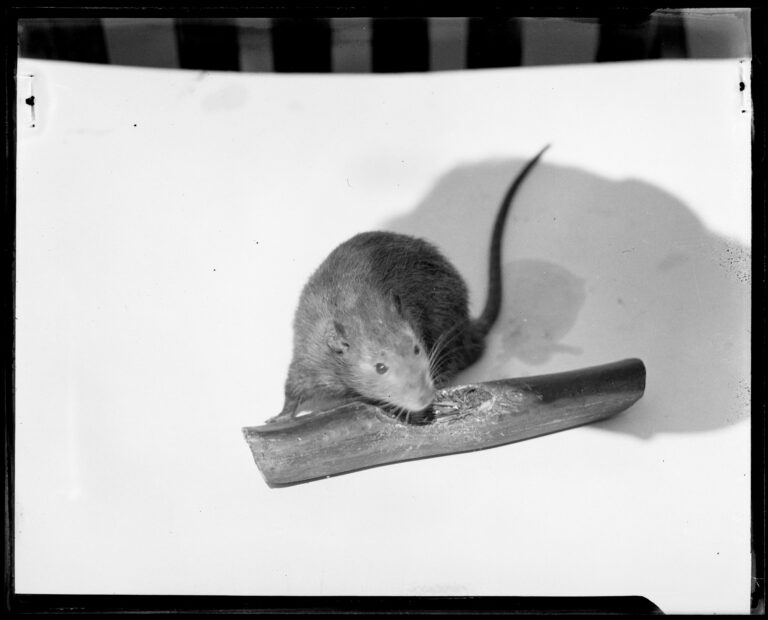
Pest Control, Rat Gnawing Cable, May 5, 1922. CHM, ICHi-164646
Having earned the title “rattiest city” in the United States for the ninth year in a row, rats hold a special place in Chicagoans’ hearts and urban lore. While some debate if Chicago indeed has the most rats per capita in the country (we’re looking at you New York), it seems to be widely accepted that Chicago reigns supreme in rat obsession if not in actual numbers.
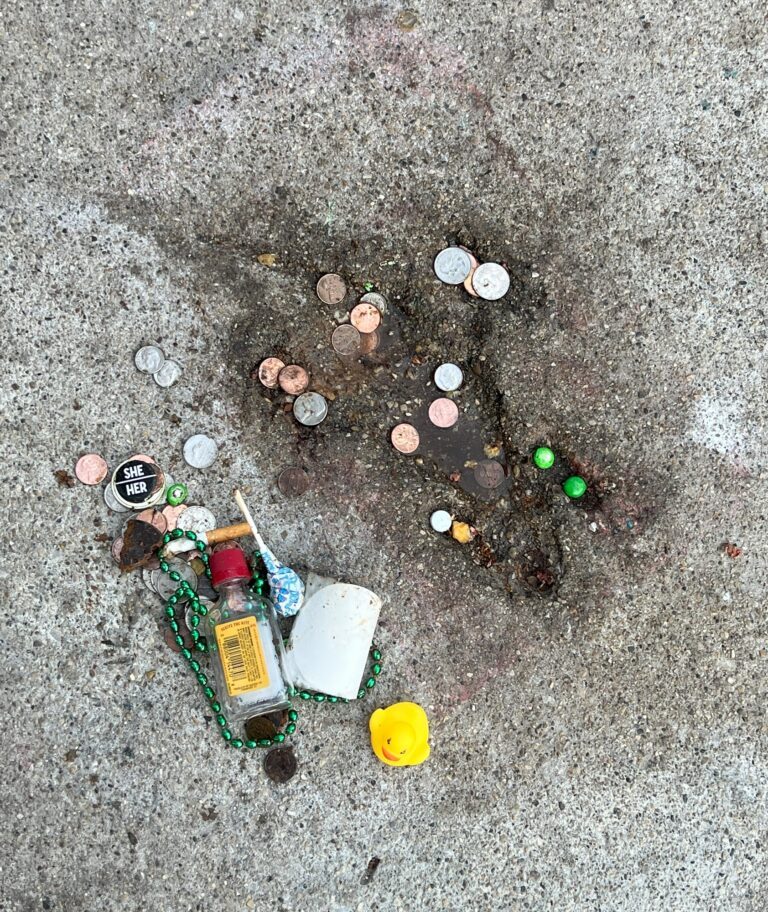
Chicago Rat Hole, 2024. Photograph by Rebekah Coffman
Chicago’s love affair with the rat has recently found a resurgence with the rediscovery of a concretized imprint of a furry rodent in a sidewalk in Roscoe Village. Now known, belovedly or bemoaningly, as the Chicago Rat Hole, it probably needs no further introduction, but I’ll briefly recap its known history just in case.

Original photograph of the Chicago Rat Hole from Winslow Dumaine’s tweet, 2024. Wikimedia Commons
Residents of Roscoe Village claim the imprint of Chicago’s furry frenemy has been in the sidewalk for decades, mysteriously appearing after fresh sidewalks were poured. It was not until January 2024 that it would reach viral status based on a quick-witted tweet, resulting in an onslaught of visitors. This quickly snowballed into visitors (some would call pilgrims) leaving objects (some would call offerings) by the hole, resulting in a happenstance shrine. There have been pilgrimages, proposals, and even a wedding all held in the presence of Chicago’s latest tourist trend, sometimes to the great chagrin of its neighbors. Despite multiple attempts to fill it back in, it miraculously remains.
As curator of religion and community history, my role looks at the ways in which Chicago has been shaped by its innumerable religious communities, expressions, and places. Sacredness and belief are found and conceptualized in diverse and unexpected ways, and religion has often spontaneously appropriated spaces around the city, including through things not traditionally considered “religion.” This line of thinking brought my colleagues and me to ask ourselves the question: Is the Chicago Rat Hole just silly, completely sacrilegious, or something uniquely sacred to Chicago?
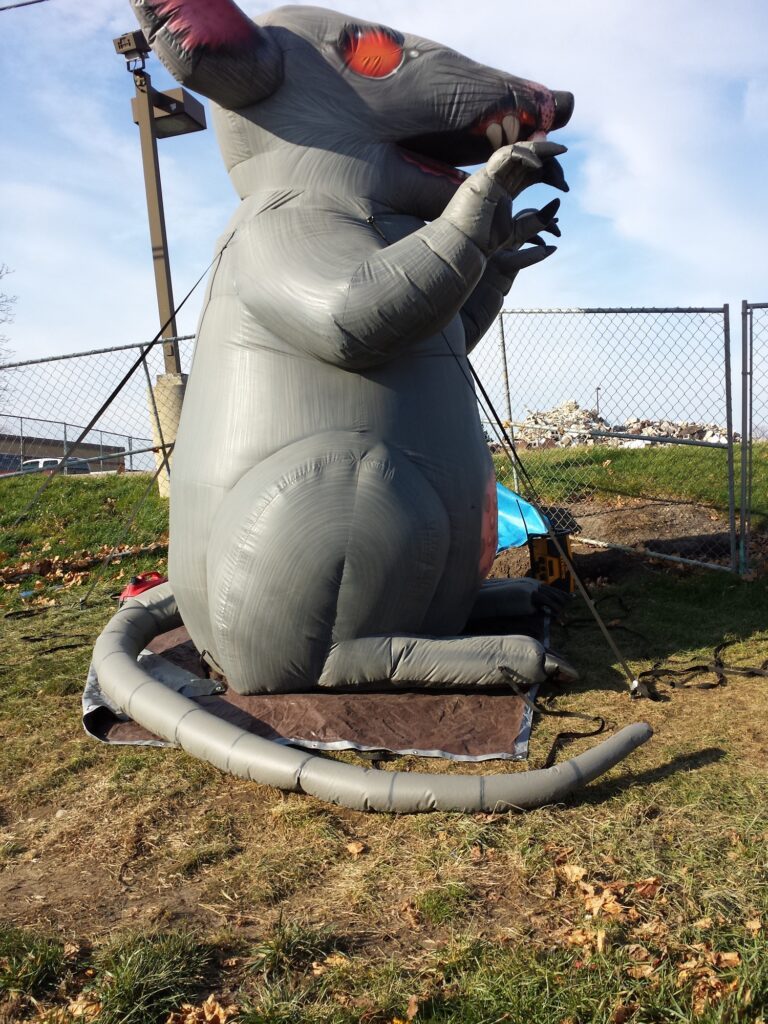
Inflatable rat in Bloomington, Illinois. Photo by Aklibbee, Wikimedia Commons
To begin, let’s take a quick stroll through rats’ known associations. Rats as creatures are reputationally mixed. On the one hand, they are intimately associated with illness, disease, and destruction, making them a verifiable pest. Their image can be negatively conflated with conniving behavior, as in the Pied Piper of Hamlin, or with picket line crossing, as with Chicago’s own “Scabby the Rat,” an inflatable rat used to bring attention to labor issues.
On the other hand, rats are positively recognized for their tenacity, quick wit, and impeccable senses of taste and smell. According to the City of Chicago, these incredible creatures are exceptional at climbing and swimming, can chew through hard materials like wood and plaster, can tread water for up to three days, and can survive a five-story fall unharmed.
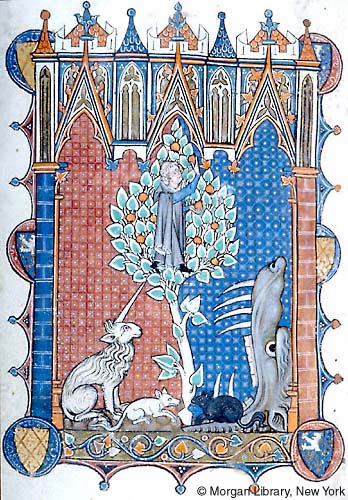
Page from the Psalter–Hours of Yolande de Soissons (1280–99) showing two rats gnawing on the trunk of the Tree of Life. MS M.729, Morgan Library and Museum Collection
This dual-sided nature also translates into religious depictions and theological understandings of rats. In Christian traditions, rats may be depicted as symbolically tied to evil and sin, sometimes depicted near Judas, the betrayer of Jesus in the Books of the Gospel, or shown in moments of destruction, as in the psalter image above.
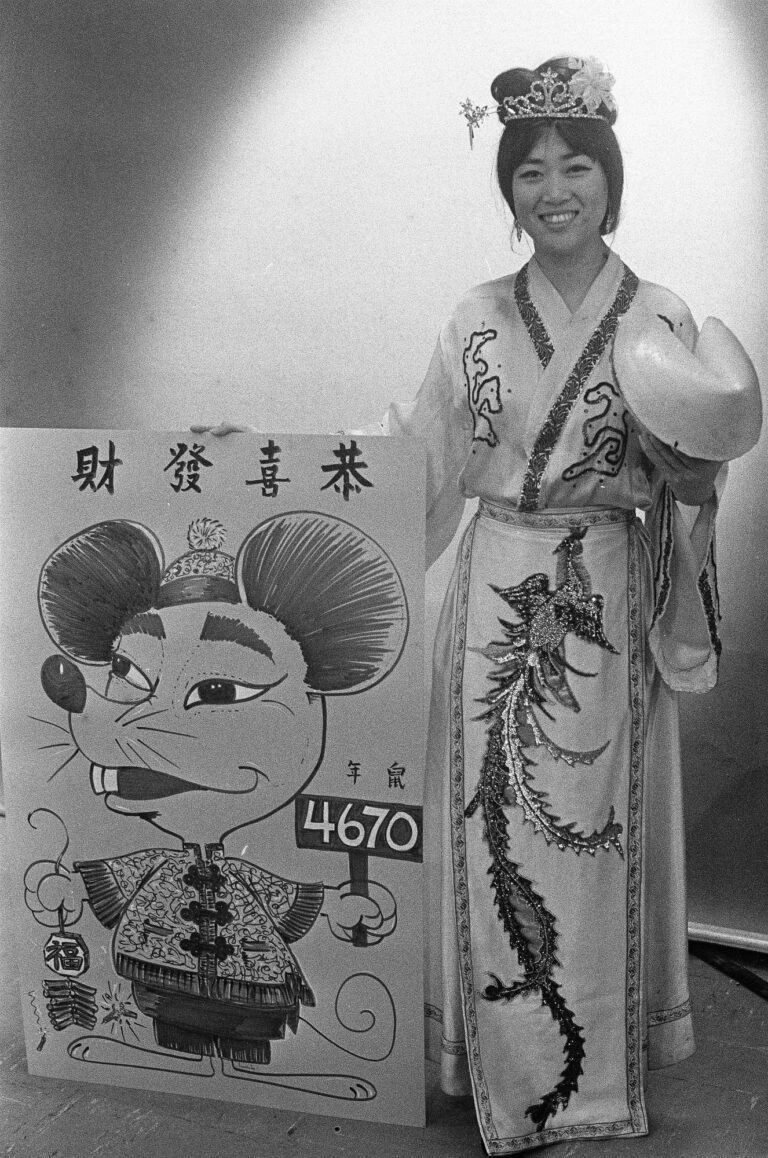
A woman in a traditional Chinese garment stands with a year of the rat sign celebrating the Chinese New Year, Chicago, January 17, 1972. ST-19033122-0006, Chicago Sun-Times collection, CHM
In other traditions, rats are centered for their positive attributes. For example, the Chinese zodiac places the rat at the start of the twelve-year cycle, associating it with traits of intelligence, perseverance, and optimism.

Above: Karni Mata Temple and below: rats drinking at the Karni Mata Temple, 2016. Photographs by Günther Jontes, Wikimedia Commons
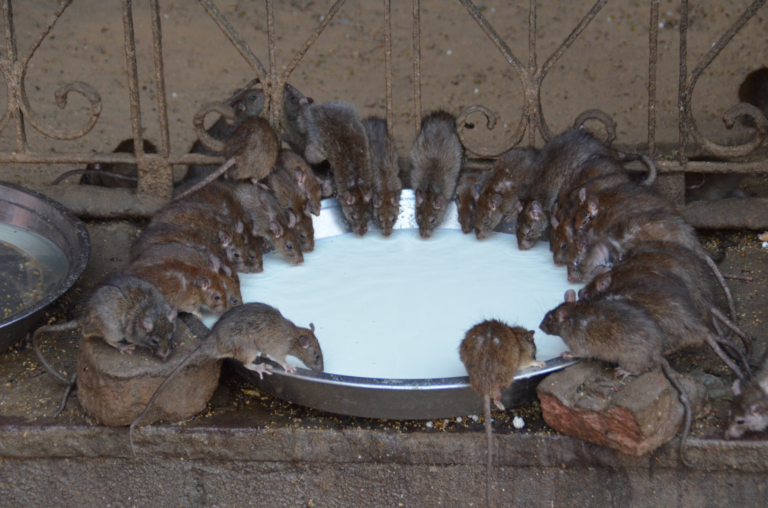
In Deshnoke, Rajasthan, India, the Karni Mata Temple or Madh Deshnoke celebrates the Hindu goddess Karni Mata who chose kābā (rats) as a symbol of power. The temple cares for thousands of rats, including providing prasad (food offerings), as the kābā are considered holy.
This handful of examples show us that the place of the rat in religion may be conflicting, but there are established iconographies, associations, and spiritual roles. The rat is justifiably religious in real and respectful contexts. But, does this necessarily translate to the comedic irony, touristy kitsch, or public nuisance that is the Chicago Rat Hole?
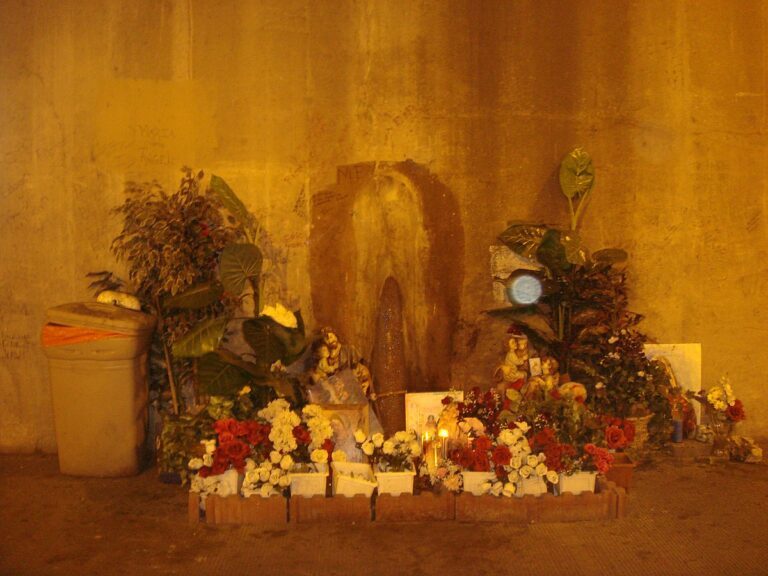
Our Lady of the Underpass (aka Salt Stain Mary), 2007. Photograph by Daniel X. O’Neil. Wikimedia Commons
The rat hole would not be the first time a happenstance shrine has resulted in a debate about material religion in Chicago. Our Lady of the Underpass, which first appeared in 2005 along Fullerton Avenue beneath the Kennedy Expressway, to some was merely a salt stain and to others became an undeniable revelation of la Virgen de Guadalupe. Catholic tradition, in fact, includes a long heritage of recognizing Marian apparitions, meaning sightings of the Virgin Mary in everyday settings and among ordinary objects. Apparitions may go through a process by which church leadership approves a given encounter as a true revelation. However, countless examples persist of someone seeing or interacting with an image of Mary, Jesus, or other religious figures that falls outside traditional parameters but remains important to believers on a spiritual level or as a secular cultural icon. In many cases, it’s a blurring of the two.
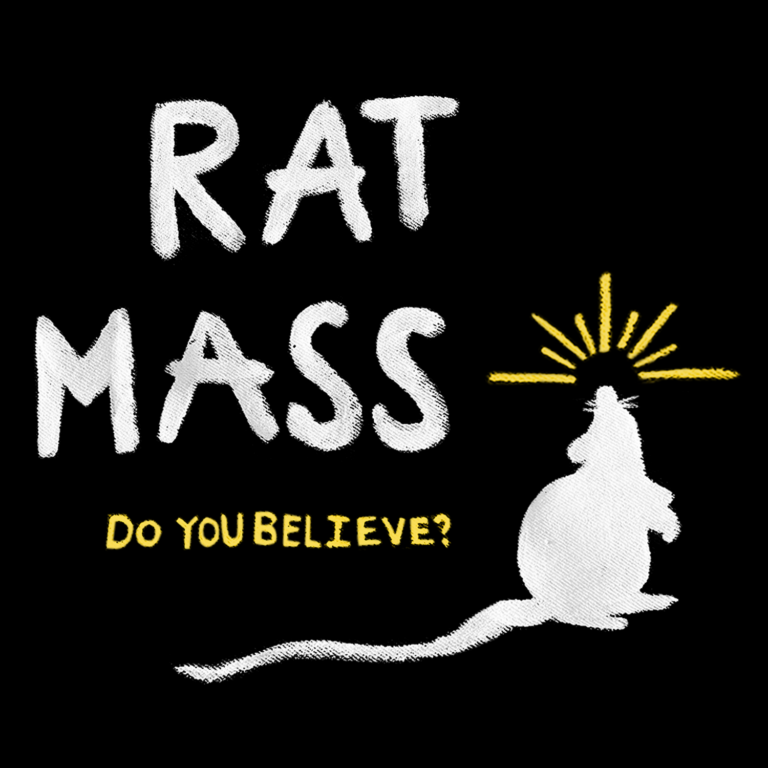
Logo for Rat Mass. Courtesy of Rat Mass.
To further explore this mixing of the spiritual with the everyday, I reached out to local rat religion experts Perry Letourneau and Joseph Bryant, makers of “ratology” and hosts of Rat Mass. Rat Mass was born in January 2023 from Joseph and Perry’s searches for meaningful community and shared interests in comedy. Through monthly performances at the Annoyance Theater in Lakeview, Rat Mass incorporates recognizably religious elements— hymns, sermons, communion, baptism—but all redefined through the lens of a Chicago rat.

Church of Ratology at the Chicago Rat Hole, 2024. Courtesy of Rat Mass.
In January 2024, at the peak of rat hole popularity, they claimed holy stewardship as the Church of Ratology. However, the rat hole was not inherently on the radar for Letourneau and Bryant when they began. The choice of the rat came from a desire to distance themselves from religious practices they had found harmful, and they searched for an animalistic representation of qualities they both admired. For them, rats are noble and adaptable with an innate ability to survive and thrive in the harshest of conditions. Additionally, because there are so many rats in the city, their presence creates a shared point of connection for Chicagoans. It’s an everyday experience that becomes a part of Chicago living, and Rat Mass’s sold-out shows suggest that experience has a real draw.
A comedy performance that parodies religion may not seem inherently like the answer for separating the sacrilegious from the sacred. However, in America’s shifting religious climate, it does reveal something very real. Religious expression is changing, but the need to find meaning and create community remains. Letourneau and Bryant asserted that while Rat Mass is a comedy performance, it is a real community gathering centered on traits they genuinely admire and to which they aspire. They see traditional religious services also as a mixture of the performative with the metaphysical as the meaning is formed by those who participate, and ratology is simply their expression.
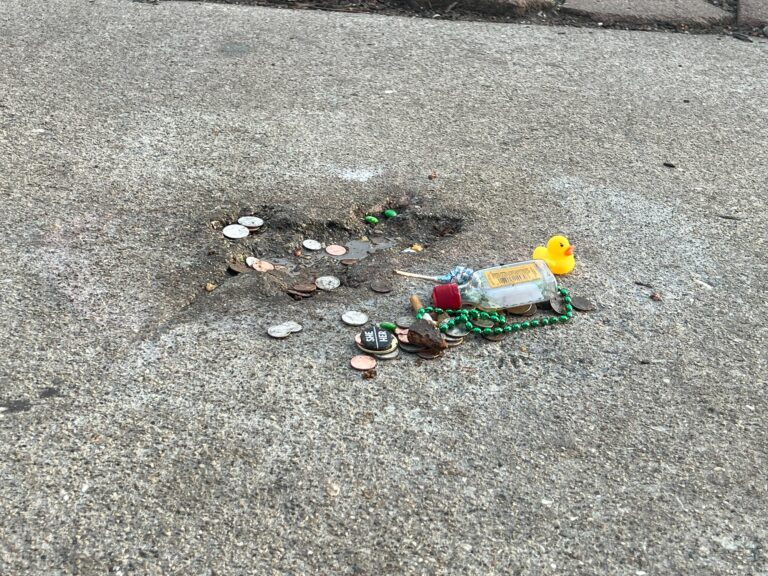
Chicago Rat Hole, 2024. Photograph by Rebekah Coffman
So, what does this mean for Chicago’s beloved rat hole? Scholars David Morgan and Sally M. Promey affirm the role an image plays in both forming memory and creating ritual in public religious expression. Images become an important way of marking group identity and creating a sense of belonging. In this case, the meaning centers on the image of the humble Chicago rat. For numerous Chicagoans, it has led to ways of coming together: performances, community gatherings, life events, general jokes, and serious conversations. It reminds us that the secular comes hand in hand with the sacred. Tourists can also be pilgrims. Kitsch may also be reverence. The Chicago Rat Hole can be simultaneously silly, sacrilege, and genuinely sacred.
To mark 100 years since Beulah Annan was accused of murder in a case that fascinated the city, CHM historian Jojo Galvan takes a closer look at the incident and how it inspired a well-known Broadway musical.
Indulging in true crime tales for leisure, whether binge-watching the newest documentary or the in-ear vibration of familiar voices and sound effects animating our favorite podcast, isn’t a new phenomenon. Time and again, rendition after rendition, some of the darkest stories in our collective history continue to draw in a breadth of diverse audiences. But why?
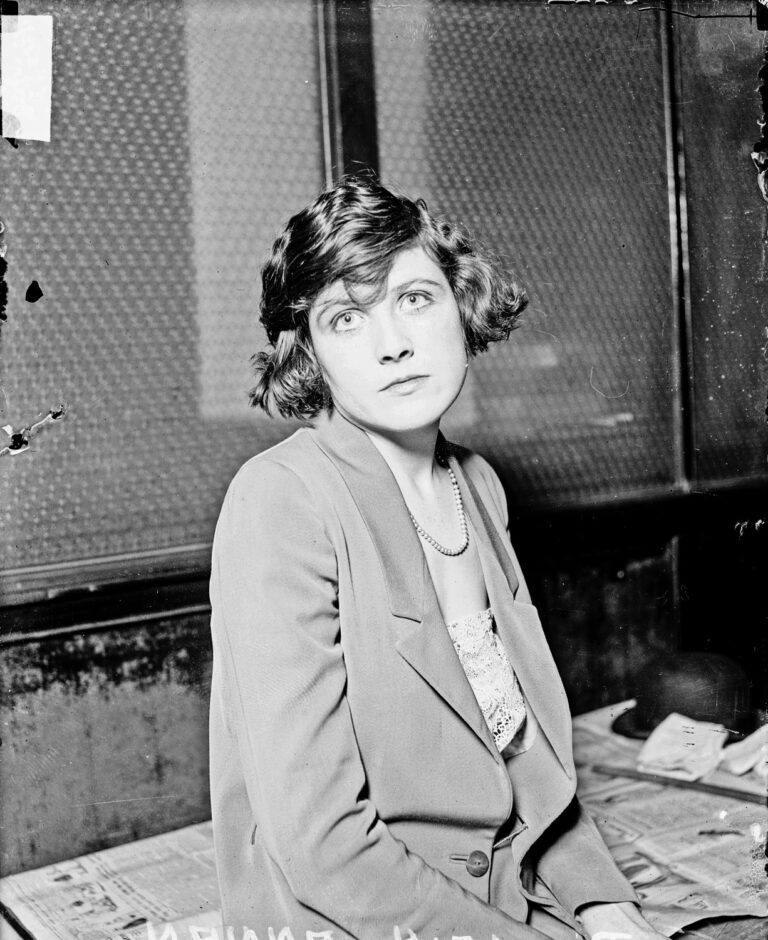
Beulah Annan, accused of killing her lover, Chicago, c. April 1924. DN-0076798, Chicago Daily News collection, CHM
One of these endlessly told stories happened 100 years ago on the South Side of Chicago, in an unassuming apartment complex in the North Kenwood neighborhood, introducing the world to the historical character of Beulah Annan. Born in 1899 in Kentucky, Beulah and her husband, Albert, arrived in Chicago at the start of the 1920s. They both held blue-collar jobs to make a living, with Beulah finding work as a bookkeeper for a local laundry. Shortly after arriving in the city, she began having an affair with a coworker named Harry Kalstedt. On April 3, 1924, Beulah and her lover had a secret rendezvous in her apartment while her husband was at work. According to Beulah’s later testimony, both she and Kalstedt had been drinking wine when a lovers’ quarrel turned deadly, and she shot him in the back with a gun she kept in her home.
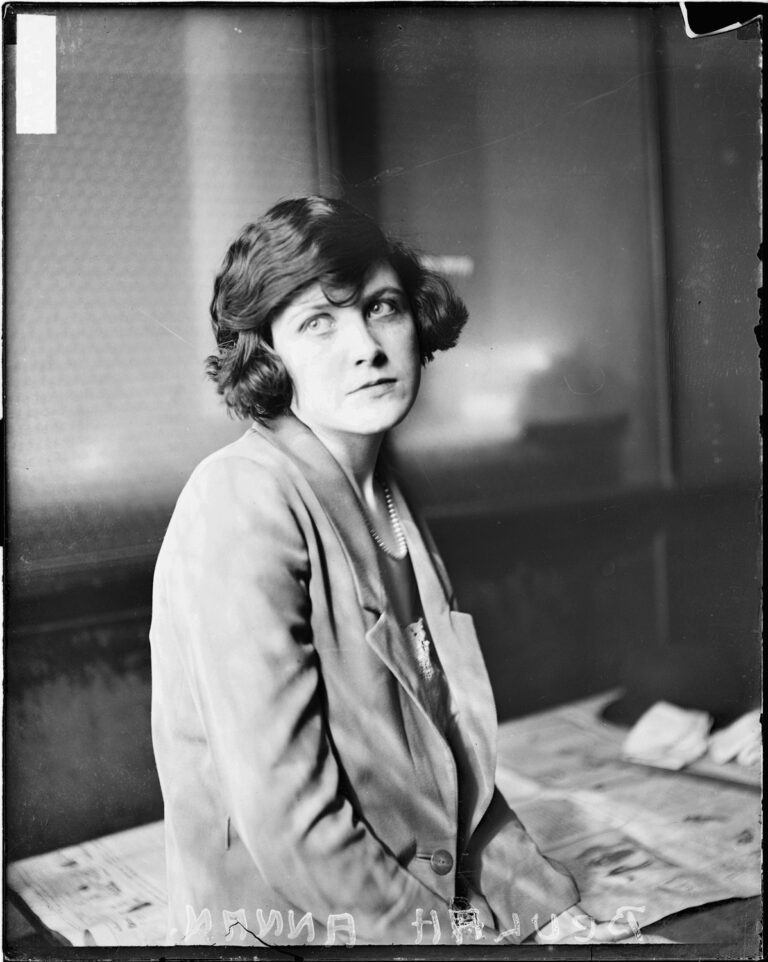
Another portrait of Beulah Annan, c. April 1924, Chicago. DN-0076797, Chicago Daily News collection, CHM
According to various reports, the fatal shot was fired around 2:00 p.m., but authorities weren’t contacted until 5:00 p.m. when Albert got home. By the next day, a media frenzy, the 1920s equivalent of going viral, ensued. The initial fascination came not from the potential murder case, but with Beulah herself. Several outlets, including the Chicago Daily News and the Chicago Tribune, all ran headlines that focused on Beulah’s attractiveness first and the fact that she potentially committed a murder second. With a trendy bob haircut and piercing eyes, Beulah only added to the fanfare behind the case when she revealed that instead of calling the authorities, she danced to her Hula Lou record for hours as Kalstedt agonized and eventually died.
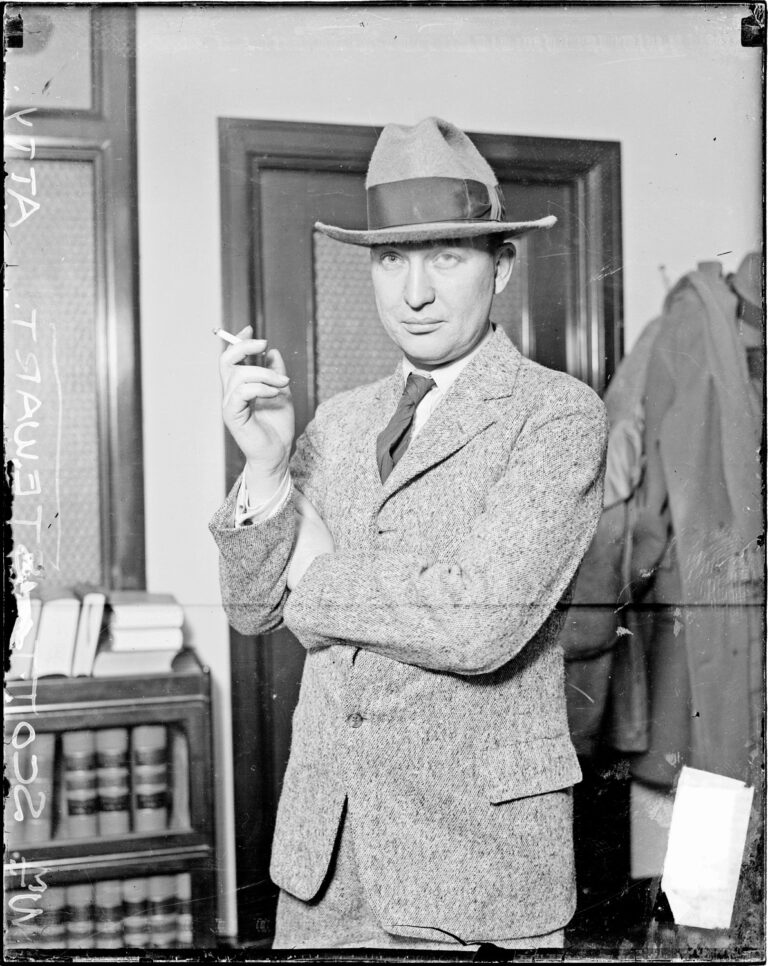
Attorney William Scott Stewart, Chicago, 1926. DN-0081521, Chicago Sun-Times/Chicago Daily News collection, CHM
The trial was just as much a spectacle as the initial reports. Albert gathered enough money to hire well-known Chicago attorney William Scott Steward, who had achieved a level of local notoriety as the legal representative for the mob. Throughout the entirety of the investigation and trial, from the statement given to the police to her cross-examination on the stand, Beulah changed her narrative no less than three times, initially admitting to the crime and later walking back her admission, claiming she feared for her safety during the argument with Kalstedt. Beulah’s husband and relatives of Kalstedt also took the stand. On May 25, 1925, a jury acquitted Beulah of her charges, and 24 hours later she announced to the media that she had separated from Albert. Their divorce was finalized in 1926. She would go on to marry two more times before succumbing to tuberculosis in 1928.
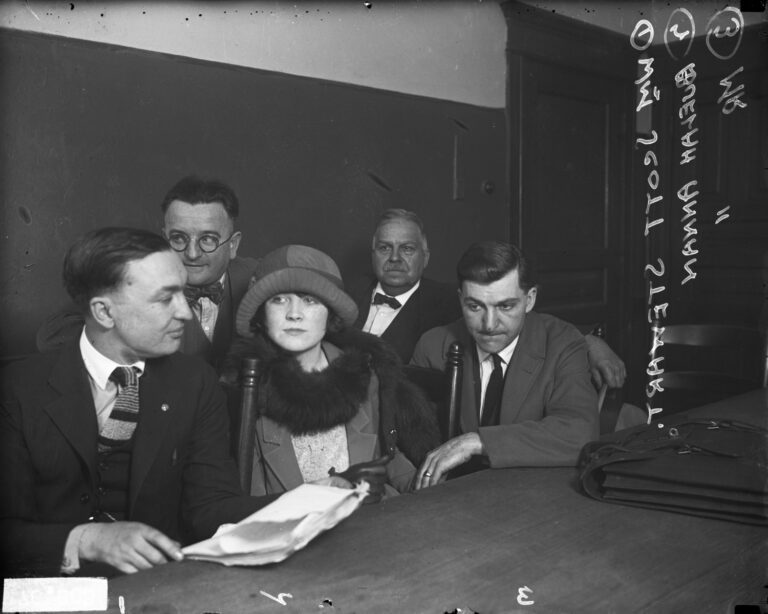
Beulah Annan and her husband, Al (right), sitting with her attorney, William Scott Stewart (left) and two unidentified men, Chicago, c. April 1924. DN-0076803, Chicago Daily News collection, CHM
While Beulah’s tale might be new to some, many are familiar with the story she inspired of scandalous love affairs and murder set in Jazz-age America. Chicago, penned initially as a play in 1926 by Maurine Dallas Watkins, the Chicago Tribune reporter on the beat for Beulah’s case, features a character named Roxie Hart, directly inspired by Beulah’s story. Chicago has been revived countless times in the theater world, including as a Broadway musical in 1975 and once more for Broadway in 1996. The 1996 revival made it one of the winningest productions in history, claiming six Tony Awards, including the award for Best Musical. In 2002, we saw Beulah’s tale again, as well as the continued success of Chicago, this time as a film directed by Rob Marshall, which won six Academy Awards, including the coveted Best Picture Award.
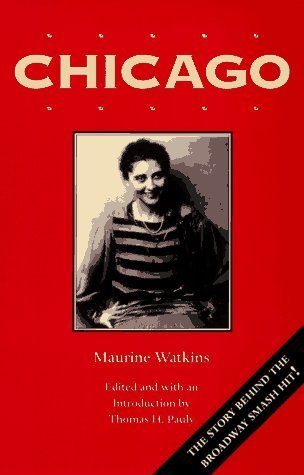
Front cover of the play Chicago by Maurine Dallas Watkins.
So, why do true crime stories continue to captivate us? The answer may be simple–they’re often fascinating in a way few other things are. Truth, as they say, is often stranger than fiction, and stories like Beulah Annan’s and countless others allow us to peek into how someone can cross the lines into committing one of the biggest taboos in the human experience, all from the safety of our homes or on the commute to work.
Additional Resources
- For more on using CHM’s collections to research other famous crimes, see our blog post “The Dark Side of the Windy City”
- Roxie Hart’s counterpart in Chicago, Velma Kelly, was also inspired by a real-life Chicago woman, Belva Gaertner. View digitized images of Gaertner at CHM Images.
- Read “Jailhouse Makeovers,” an excerpt from Douglas Perry’s The Girls of Murder City: Fame, Lust, and the Beautiful Killers Who Inspired Chicago
With the city’s unpredictable Midwestern weather, Chicago’s outdoor athletes have had to get creative when it comes to staying active indoors. In this blog post, editor and content manager Heidi Samuelson writes about the rise and fall of indoor baseball and its continued legacy.
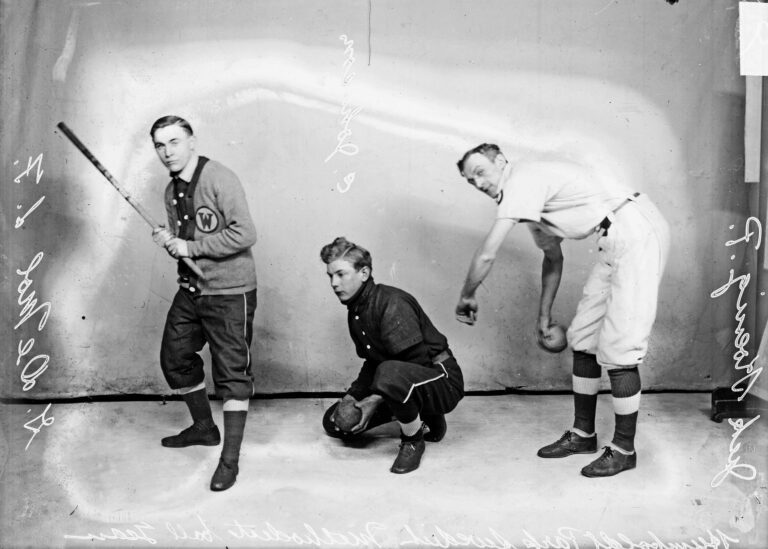
Portrait of G. De Mol (holding a bat), E. Johnson (kneeling), and Jack Hoenig (pitching stance) of the Humboldt Park Swedish Methodist indoor baseball team, 1909. SDN-007248, Chicago Daily News collection, CHM
Indoor baseball originated on Thanksgiving Day 1887 by George Hancock, a reporter at the Chicago Board of Trade, at the Farragut Boat Club on Chicago’s South Side. The story goes that he went to the club to find out the score of the Yale-Harvard football game, where a group of Yale and Harvard alums were following the game via telegram. Yale lost the game. After a Yale alumnus jokingly threw a boxing glove at another member who batted it away with a stick, Hancock got the idea to draw a diamond on the gymnasium floor. With a rough set of rules, the members began playing the first game of “indoor baseball” with a tightly wrapped glove and a stick. By winter’s end, the boat club was playing games with other clubs.
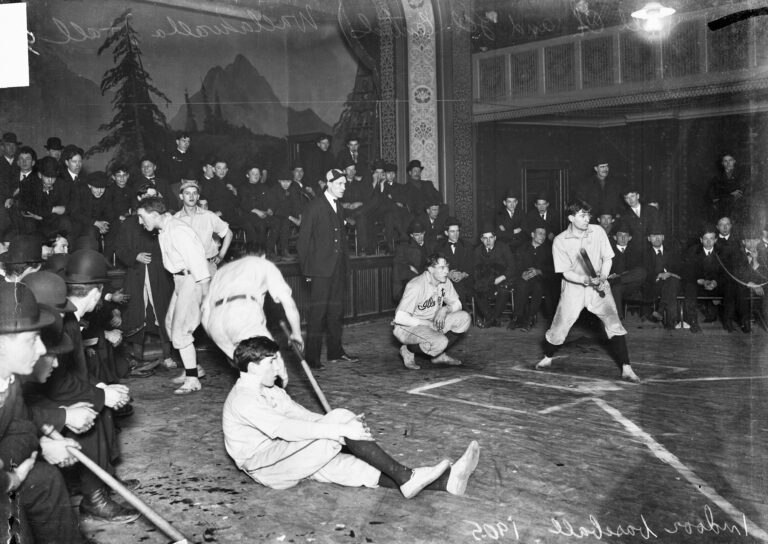
Chicago-Illinois Central indoor baseball game in a gymnasium, Chicago, 1905. SDN-003190, Chicago Daily News collection, CHM
The basic equipment for “indoor baseball” was a soft 17-inch ball and a thin, stick-like bat. Players didn’t wear gloves, the bases were placed 27 feet apart (compared to 90 feet apart on an outdoor baseball diamond), and the pitcher was only 22 feet from home plate. The game appealed to rowers, who were stuck indoors in winter months, but it soon spread across the Chicago area. By winter 1891–92, there were more than 100 teams organized in amateur leagues.
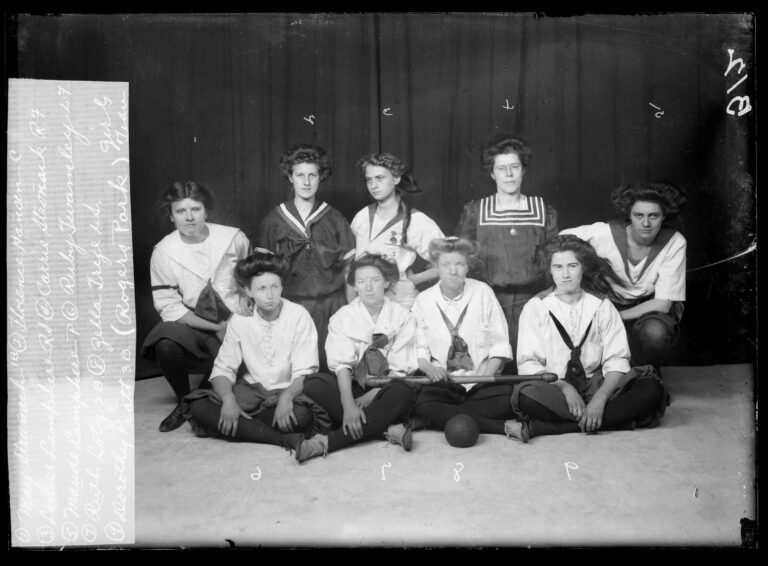
Group portrait of members of the Rogers Park girls’ indoor baseball team, 1909. SDN-007848, Chicago Daily News collection, CHM
Colleges and high schools, girls and boys, began to embrace the sport a few years later in December 1895, when 10 schools formed a league. Indoor baseball was particularly popular on the city’s West Side, and English High (later Crane Tech), Medill, and West Division (later McKinley) were dominant in league play. In 1899, West Division formed a girls’ league, having started playing intermural games in 1895, which included the West Side’s Marshall and Medill.
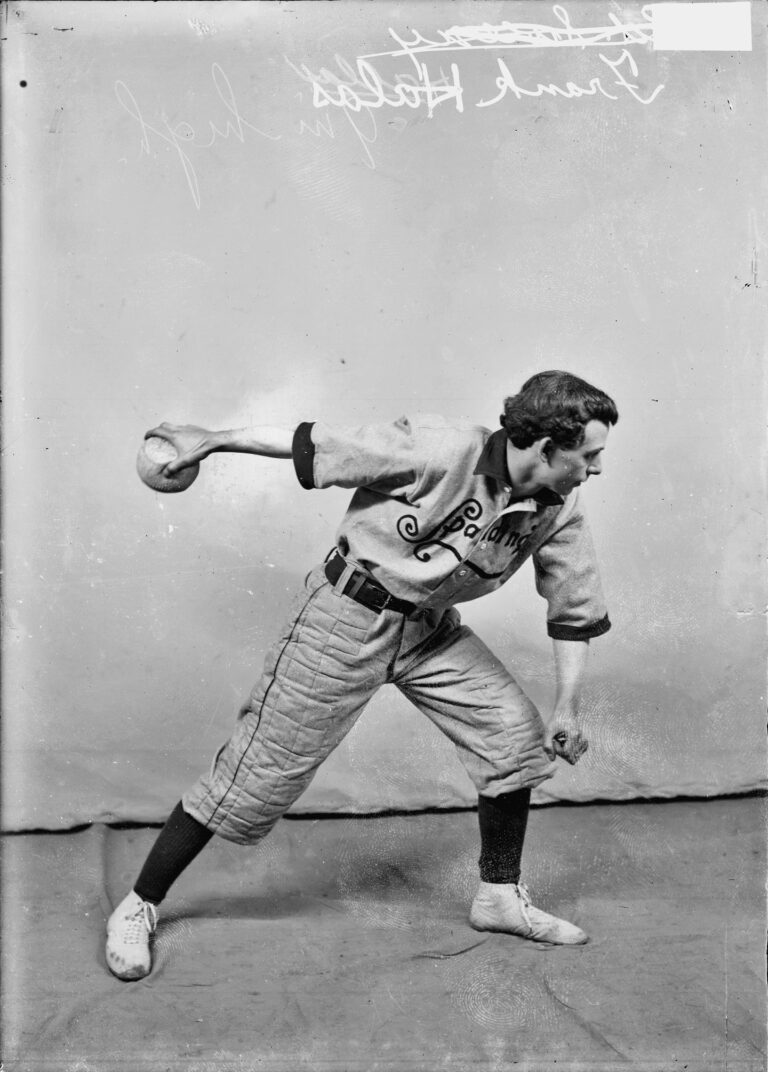
Frank Halas, indoor baseball player, winding up for a pitch, 1907. SDN-005286, Chicago Daily News collection, CHM
The sport was particularly popular among Czech Americans. Among its notable players were the Halas brothers, including George Halas, future owner of the Chicago Bears. George’s older brothers Frank and Walter were both standout players. The Halas brothers played at Crane Tech, and Frank also played in the Chicago Indoor Baseball League.
Around 1907, players began moving the game outdoors, changing the name to “playground ball” and later “softball.” In the 1910s, the indoor version declined in popularity, due to the rapidly growing popularity of basketball, and by the 1920s, indoor baseball was essentially nonexistent.
However, its legacy continued through 16-inch slow-pitch softball, sometimes called Chicago ball. The first 16-inch softball national championship was held during the 1933–34 A Century of Progress world’s fair. From there, a professional league formed, which existed through the 1950s. The sport is still played in Chicago today in recreational leagues, and you can visit the 16 Inch Softball Hall of Fame in Forest Park, Illinois.
Additional Resources
- Encyclopedia of Chicago entry on Indoor Baseball
- Encyclopedia of Chicago entry on Softball
- “Indoor Baseball in Chicago High Schools, 1892 to 1919” by Robert Pruter
- “Chicago High School Girls Pioneer Indoor Baseball for Women” by Robert Pruter
- See more images of indoor baseball on CHM Images
CHM senior public and community engagement manager Greg Storms recalls the life of Mama Gloria Allen, an African American transgender activist, and her impact on Chicago’s LGBTQIA+ community.
In late 2011, I moved to Chicago to research segments of the city’s LGBTQIA+ community and its history. Soon after I moved here, I was connected to Center on Halsted, the Midwest’s largest LGBTQIA+ community center, which is located in the Lakeview community area. A couple years later, I found myself working there overseeing Youth Services and engaging LGBTQIA+ young folk, especially those experiencing homelessness. Unsurprisingly, a disproportionate number of those individuals are gender expansive, nonbinary, and/or transgender. It was also during this time that I met Gloria Allen, affectionately known to everyone around her as “Mama Gloria.”
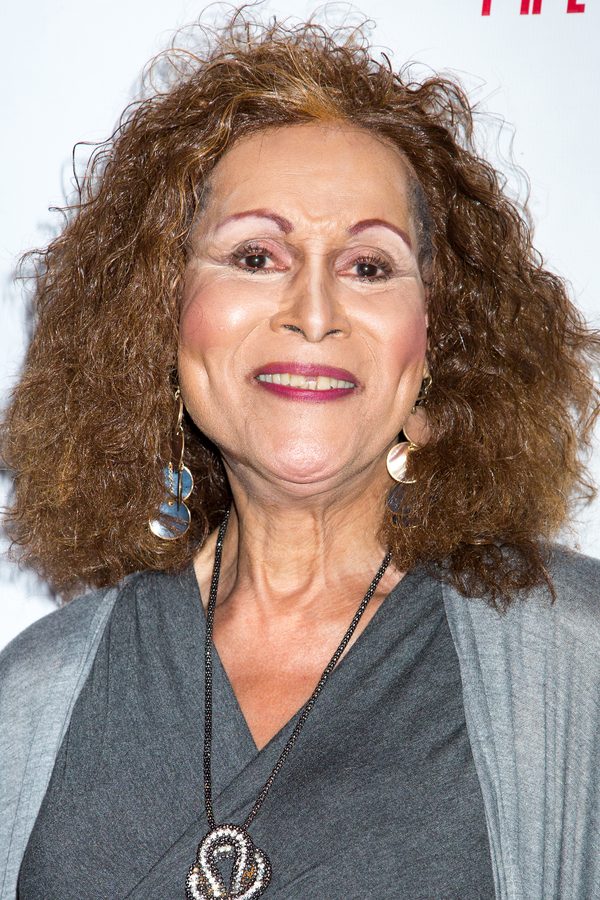
Gloria Allen, c. 2022. Image from Wikimedia.
Mama Gloria was an African American transgender woman who left an indelible mark on our community. I first heard about her and her “Charm School” through Youth Services staff before meeting her in person.
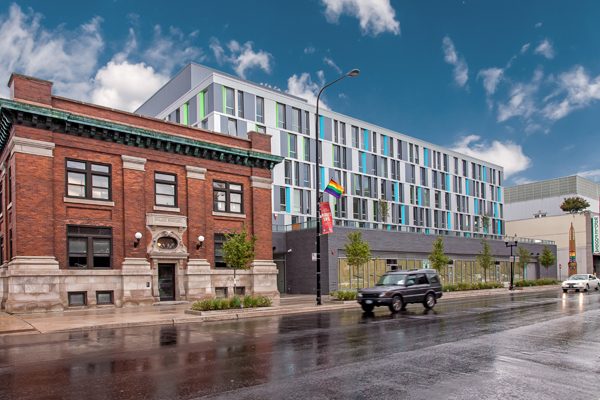
Center on Addison at 806 N. Addison St. (left) is part of Center on Halsted, serving as a space for Senior Services programming for LGBTQIA+ older adults. It is connected to Town Hall Apartments (center background), a senior living facility where Gloria Allen lived in her later years.
Charm School was a workshop Mama Gloria offered primarily to young folks of transgender experience as a sort of lesson in etiquette. As she said, “Manners are important to me. You have to know how to talk to a person, listen to them, and have fun with them.” But these lessons weren’t really about etiquette alone. They were an opportunity to forge new intergenerational relationships, to offer these young people a role model, an elder to whom they could look with respect. This was especially important given how few elder transgender role models are still with us today. As Mama Gloria herself would often recount, transgender women were “either beaten or murdered,” something that many younger transgender people today think will happen to themselves, too.
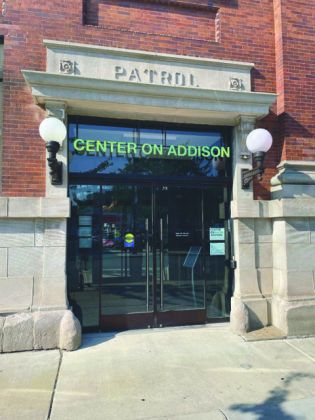
Center on Addison was formerly the Chicago Police Department Town Hall station in Lakeview, one of many locations in Chicago where LGBTQIA+ folks were incarcerated in earlier decades, making its transformation into a LGBTQIA+ senior living center an important symbolic victory for the community.
These young folks were able to benefit from Gloria’s long and full life. Born October 6, 1945, in Bowling Green, Kentucky, and raised in Chicago, she was fortunate to have a supportive family. Her mother, Alma Dixon, was a source of lifelong support and affirmation. Her maternal grandmother, Mildred, was also pivotal in Gloria’s life. Both women worked in and around the entertainment industry. Alma was a showgirl and Jet magazine centerfold; Mildred was a seamstress who often did work for drag queens and male strippers during Gloria’s youth. Both knew transgender women through their work before the word transgender was even coined decades later. (For example, Merriam-Webster Dictionary states the first known use of “transgender” was in 1974.) Other members of her extended family also supported her transition and remained close throughout her life.
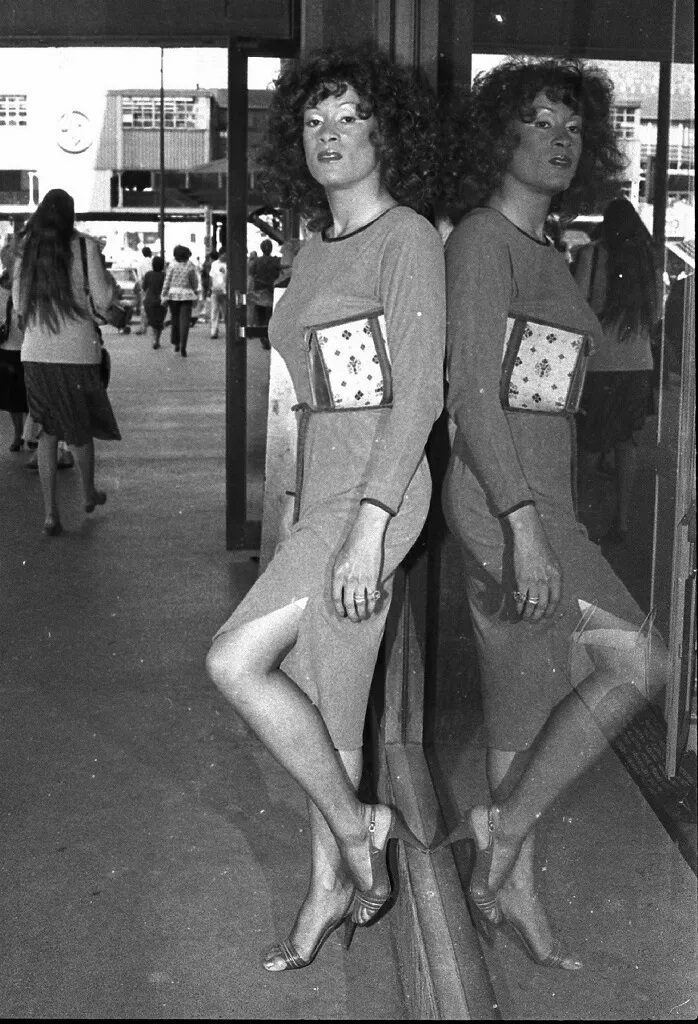
Gloria Allen, c. 1970. Image from Block Club Chicago
Still, even with family support, Mama Gloria faced a number of life challenges as an African American transgender woman growing up in the mid-twentieth century. Facing hate-motivated violence and harassment, domestic violence, barriers to educational and employment opportunities, and a gradually developing system to support social and medical transition, Gloria Allen was confronted with significant challenges. Despite these challenges, however, she lived her life the way she wanted and became a beloved member of Chicago’s LGBTQIA+ community.
Her Charm School gained journalistic attention, which later led to new opportunities like a theatrical play by Philip Dawkins, Charm, based on her life. She was recognized by transgender writer and activist Janet Mock at the Trans 100 Awards in 2014 and was the subject of a 2020 documentary about her life called Mama Gloria.
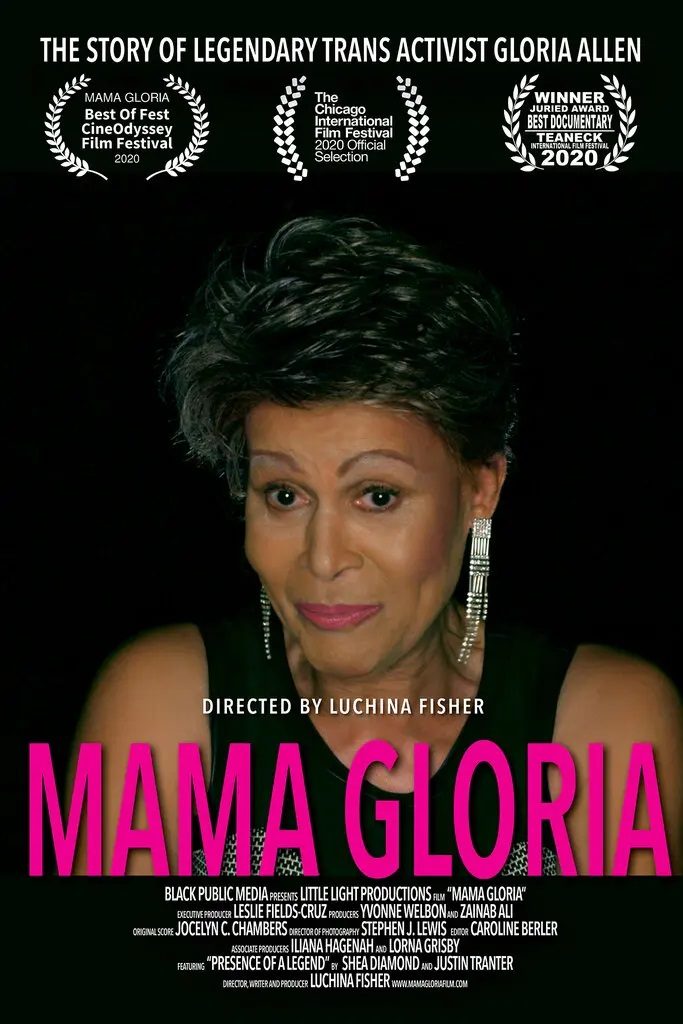
The cover of Mama Gloria. The film was nominated for a 2022 GLAAD Media Award.
Sadly, Gloria Allen died on June 13, 2022, at the age of 76. I clearly remember learning of her death from friends and colleagues. It was a loss to the entire community, but her memory lives on in the lives of the young folks who were fortunate enough to know, learn from, and love her like the chosen mother that she was.
Additional Resources
- Our Abakanowicz Research Center houses the Gloria Allen papers [manuscript], approximately 1945–2022
- Watch Mama Gloria on PBS (free streaming through April 30, 2024)
- Learn more about The Trans 100 and read their publication from 2014 featuring Mama Gloria
- Read GLAAD’s “Glossary of Terms: Transgender” in their Media Reference Guide – 11th Edition
- Learn more about the Center on Halsted
For Christians around the world, Palm Sunday marks the start of Holy Week leading into Easter Sunday. In this blog post, CHM curator of religion and community history Rebekah Coffman writes about the Polish traditions behind the day and when Polish president Lech Wałęsa attended a Palm Sunday Mass in Chicago in 1991.
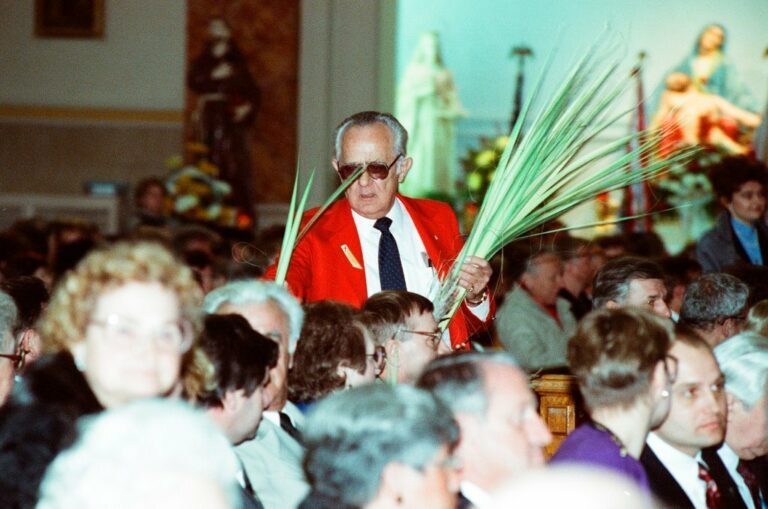
An usher distributes palm fronds at Palm Sunday Mass at St. Hyacinth Basilica, 3636 W. Wolfram St., Chicago, March 24, 1991. ST-19041696-0220, Chicago Sun-Times collection, CHM
In Christianity, Palm Sunday commemorates Jesus’s entry to Jerusalem when he was greeted by crowds waving palm branches. Many churches today across Christian denominations distribute palm fronds during services as preparation for the coming reminder of rebirth and life overcoming death.
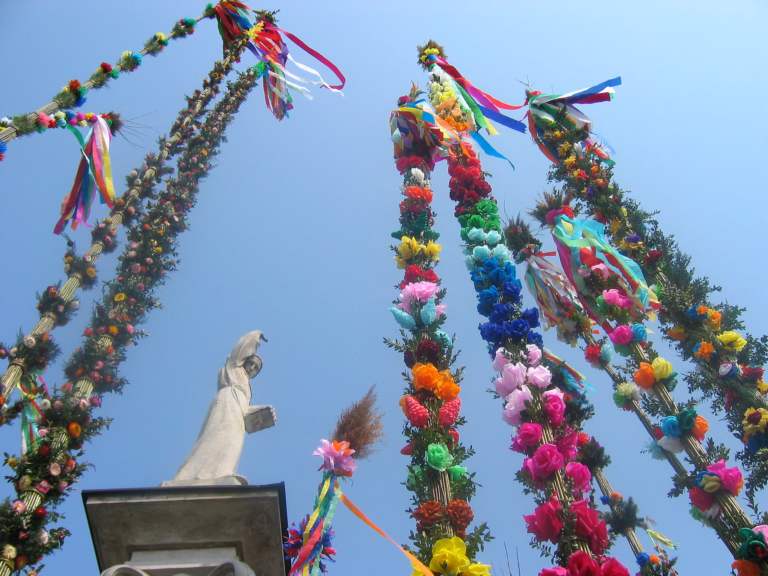
Palm Sunday in Lipnica Murowana, Poland, 2004. Maciej Szczepanczyk, Wikipedia Commons.
In Polish tradition, processions of palms take a major step beyond waving a single green branch. In fact, because palms are rare in Poland, palm branches are sometimes forgone completely, and beautiful bundles of willow (wierzba) and colorful bouquets of dried flowers are used instead. These incredible bundles are used in Sunday church services and afterward may be brought home or planted in fields as symbols of good luck. Some areas in Poland take decorating palms to a whole new level and hold annual contests for the tallest and most decorative display.

Palm traditions have extended here to Chicago, as can be seen in these images from a Palm Sunday service at St. Hyacinth’s Basilica (Bazylika Świętego Jacka) in the Avondale community area. St. Hyacinth’s was founded in 1894 by a group of Resurrectionists from St. Stanisłaus Kostka. Initially in a modest wood building, the congregation’s impressive Polish Cathedral-style church was built from 1917 to 1921.

Overhead view of parishioners celebrating a mass at St. Hyacinth Basilica, Chicago, December 11, 1983. ST-19041501-0006, Chicago Sun-Times collection, CHM
The area of Avondale surrounding St. Hyacinth’s is also known as “Jackowo,” which when paired with the area surrounding nearby St. Wenceslaus Church (known as “Wacławowo”), is more generally known as the Polish Village. Avondale is historically known as a working-class neighborhood, developing along the Chicago River, rail lines, and brick factories. Beginning in the 1870s, a community of Black families in the Dawson subdivision called Avondale home. In the next few decades, the neighborhood quickly shifted as an influx of European migrants from Germany, Sweden, and Austria followed.

Pedestrians on North Milwaukee Avenue in Avondale, Chicago, January 24, 1975. ST-90003274-0020, Chicago Sun-Times collection, CHM
By 1930, nearly a third of Avondale identified as Polish, and the neighborhood remained predominantly Polish through the 1980s. Today, over half of Avondale identifies as Hispanic or Latine, with traces of its Polish Village community still present, though recent gentrification is once again shifting the neighborhood.

A crowd of people line the street to see Polish president Lech Wałęsa as he attends Palm Sunday Mass at St. Hyacinth Basilica, Chicago, March 24, 1991. Two people hold signs that welcome him and say “Solidarność,” which means “Solidarity” in Polish. ST-19041696-0190, Chicago Sun-Times collection, CHM
The Polish Avondale “heyday” of the 1980s and 1990s aligned with the Solidarity Movement in Poland, and Polish migrants to Chicago of this period included a number of political refugees escaping Communist rule. St. Hyacinth’s was a hub for Solidarity-era activity. In 1991, a large crowd of Polish Americans welcomed Solidarity leader and then-newly elected President of Poland Lech Wałęsa to St. Hyacinth’s for Palm Sunday Mass.

Lech Wałęsa (holding palm fronds and flowers) and his wife, Danuta, at Palm Sunday Mass at St. Hyacinth Basilica, Chicago, March 24, 1991. ST-19041696-0181, Chicago Sun-Times collection, CHM

Lech Wałęsa (left foreground) genuflects during Palm Sunday Mass at St. Hyacinth Basilica, Chicago, March 24, 1991. ST-19041696-0158, Chicago Sun-Times collection, CHM
Solidarity initially referred to a trade union formed at the Lenin Shipyard in Gdansk, Poland, in 1980, which would go on to become the first independent trade union recognized by the state as part of the Warsaw Pact. As a leader of the Solidarity movement, Wałęsa was pivotal to ending Poland’s communist rule and became the first democratically elected president since 1926. He was president of Poland from 1990 to 1995.

Lech Wałęsa and his wife, Danuta, handle a wreath outside St. Hyacinth Basilica, Chicago, March 24, 1991. ST-19041696-0138, Chicago Sun-Times collection, CHM
After the service, Wałęsa and his wife, Danuta, placed a wreath before a monument outside the church commemorating Fr. Jerzy Popiełuszko, a priest in Poland who was supportive of Solidarity and murdered by agents of Poland’s Security Service of the Ministry of Internal Affairs. Rev. Popiełuszko was recognized as a martyr by the Catholic Church and exemplifies the role churches played in the resistance movement during the antireligious suppression of the Communist era.
Additional Resources
- Listen to CHM’s Peter T. Alter interview Lech Wałęsa in 2012
- See more images of Lech Wałęsa visiting St. Hyacinth Basilica in 1991
- Learn more about Chicago area’s vibrant Polish communities from the mid-1800s to today in our exhibition Back Home: Polish Chicago (May 20, 2023–June 8, 2024)
For St. Patrick’s Day, CHM curator of religion and community history Rebekah Coffman looks at Old St. Patrick’s Church as a monument to Chicago’s longstanding Irish community presence and how its stained glass windows reflect Irish American identity.

Old St. Patrick’s Church, also known as St. Patrick’s Roman Catholic Church, 2024. Photograph by Rebekah Coffman
St. Patrick’s Day in Chicago means the city is filled with Irish heritage on display. While Chicago may be best known for its green river, festive parades, and raucous pub crawls, Old St. Patrick’s Church in the West Loop neighborhood is a monument to Chicago’s longstanding Irish community presence.

Old St. Patrick’s Church, August 4, 1975. ST-19042225-0002, Chicago Sun-Times collection, CHM
Named for the patron paint of Ireland, Old St. Patrick’s Church was founded on Easter 1846 by Irish bishop William Quarter as the first English-speaking Catholic church in Chicago. Initially in a humbler wooden building at the intersection of Randolph and Desplaines Streets, the cornerstone was laid for a new brick building on May 23, 1853. Completed in 1856, the church would be one of a handful of buildings to survive the Great Chicago Fire of 1871, making it the oldest public building in Chicago today.

Cartoon by L. V. H. Crosby depicting “the Origin of the Great Chicago Fire” featuring a stereotyped image of Catherine O’Leary and her cow in a barn. CHM, ICHi-002945
Irish immigration to Chicago began in the 1830s and grew exponentially following serial potato crop failures beginning in 1845. By 1860, Chicago had the fourth largest Irish community in the country. Religious divides present in Ireland found their way to the Irish immigrants’ new home, with Protestants separating themselves from Catholics by both religious identity and social and economic class. Soon, Irishness in Chicago became publicly synonymous with Catholic and working-class or poor. Prejudice against Irish immigrants led to pervasive social stereotyping during this time, including the legendary story of Mrs. O’Leary and her cow as the source of the Great Chicago Fire.

View of the Irish Village at the 1893 World’s Columbian Exposition with a banner reading “Cead Mile Failte” meaning “Welcome.” CHM, ICHi-022941
Two decades later, Irish presence and identity were again on display as part of the 1893 World’s Columbian Exposition. Two idealized Irish villages were included in the ethnographic displays along the Midway Plaisance, where visitors could see glimpses of the romanticized “everyday life” of the rural Irish. The setting included thatched cottages, a reproduced Muckrass Abbey, a recreation of Blarney Castle (complete with a place to kiss a piece of the Blarney Stone), and various cultural displays, including Celtic arts and crafts. This and other romanticized visions of an Irish homeland would go on to influence artists and designers looking for inspiration amidst the chaotic progress of the Industrial Revolution, including a young man by the name of Thomas O’Shaughnessy. He would become a cornerstone in defining Chicago’s flavor of the Celtic Revival Style.

Artist Thomas O’Shaughnessy with a stained-glass tile featuring a Celtic design, May 16, 1914. DN-0062780, Chicago Daily News collection, CHM
Born in 1870 and originally from Missouri, O’Shaughnessy studied stained glass at the School of the Art Institute of Chicago, learning from local stained glass legend Louis Millet. Millet is perhaps best known for designing nature-inspired windows for buildings such as Louis Sullivan’s Auditorium Building and, with partner George Healy, the dome in the Grand Army of the Republic Hall at what is now the Chicago Cultural Center. O’Shaughnessy would later take the techniques he learned and apply them to a new visual language steeped in Irish heritage.

Artist Thomas O’Shaughnessy working on a piece of stained glass art, 1920. DN-0072728, Chicago Daily News collection, CHM
As noted above, O’Shaughnessy became deeply inspired by Celtic design, first encountering it at the 1893 World’s Columbian Exposition. In 1905–6, after he finished his formal studies and started work as an illustrator for the Chicago Daily News, O’Shaughnessy traveled in Europe to gain wider artistic inspiration.


Pages from the Book of Kells, 9th century, Trinity College Dublin.
While in Ireland, he was particularly drawn to the themes and pattern work he saw in the Book of Kells, a 9th-century illuminated manuscript containing the four books of the Christian gospels (Matthew, Mark, Luke, and John). The Book of Kells is widely known for its impressive ornamentation and pages of illustration that infuse Celtic imagery and design with the Latin text of Christian scripture. These designs became a major source of inspiration for many artists during the late-19th and early 20th centuries as part of the Celtic Revival, and Celtic designs were documented, replicated, and incorporated in a number of fine and decorative arts.


Stained glass windows at the balcony of St. Patrick’s Church, 2024. Photographs by Rebekah Coffman
O’Shaughnessy brought this influence into his design work for St. Patrick’s Church, creating a distinctive hybrid Irish-meets-American style. He designed and installed fifteen major windows from 1912 to 1922, each incorporating Celtic elements to visually assert Irish American identity through the building’s decoration. Irish-born Chicagoans were at a near-peak in the city until quickly tapering after the Immigration Act of 1924.


St. Patrick’s Day Parade on State Street, Chicago, March 17, 1976. ST-15003202-0105 and ST-15003202-0107, Chicago Sun-Times collection, CHM
Irish immigration to Chicago was halted almost completely during the Great Depression until the 1950s, with a final big wave arriving after leaving during Irish unrest of the 1970s–90s. Today, more than 430,000 people in Cook County claim Irish ancestry and organizations like the Irish American Heritage Center in Irving Park continue to share and celebrate Irish presence in the city. While a number of formerly Irish parishes have shifted in use or been lost to demolition, Old St. Patrick’s stands today as a reminder of long-standing community presence.